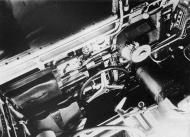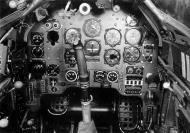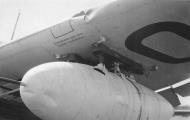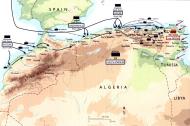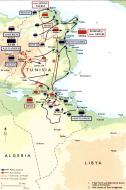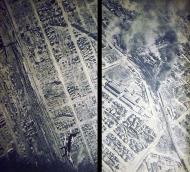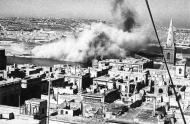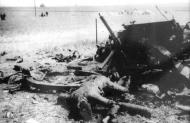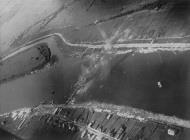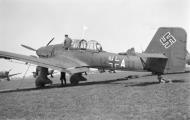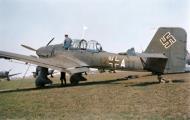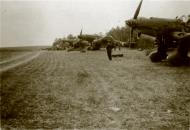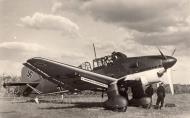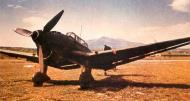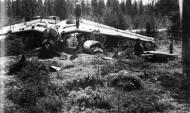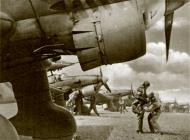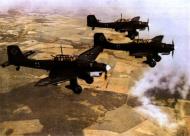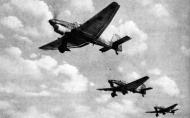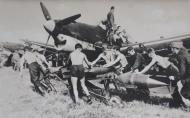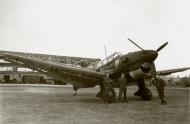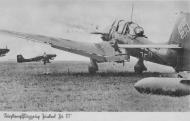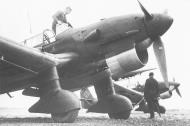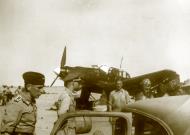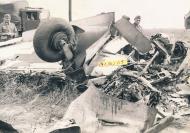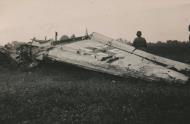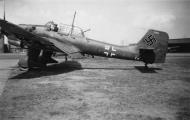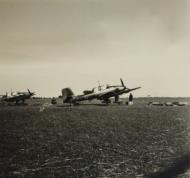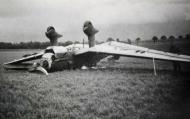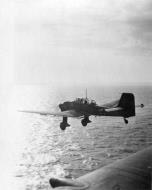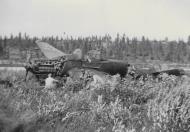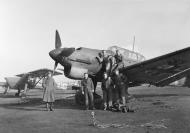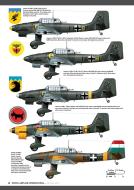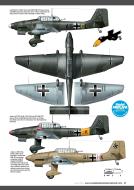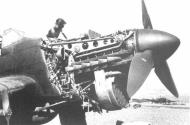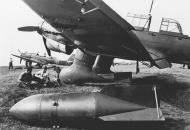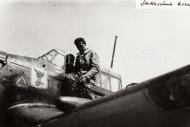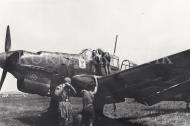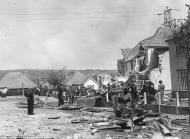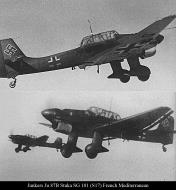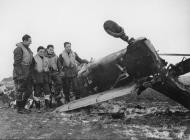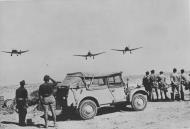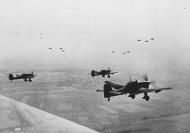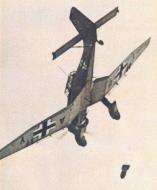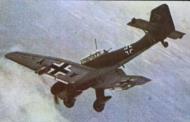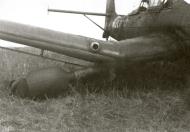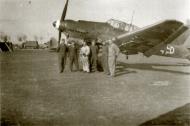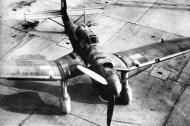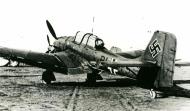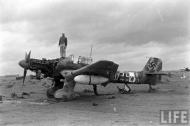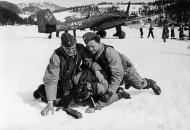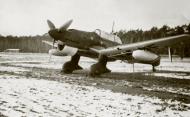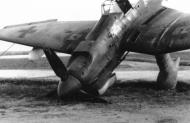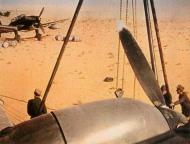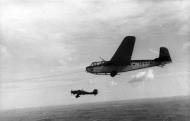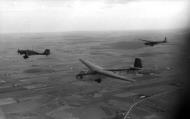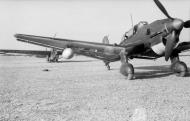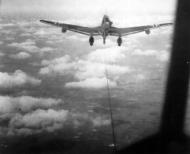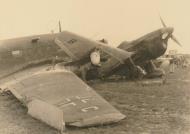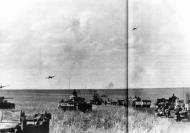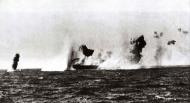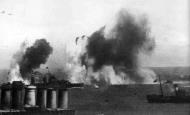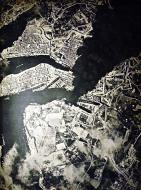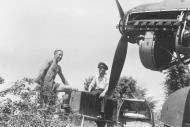Aircraft factory Junkers Ju 87B Stuka assembly line at Weser plant after RAF bombing raid June 30th 1940 01
Artwork showing a map of deployment of German forces prior to Operation Barbarossa 22nd June 1941 0A
Ground targets hit by Stukas dust clouds cover the area after a Geramn and Italian raid on Malta 1941 01
Junkers Ju 87 Stuka StG2 pilot Josef Weissenbrunner with Martin Mobus how he sd a Soviet fighter NIOD
Naval targets hit by Ju 87 Stuka flying over a sinking Russian Navy destroyer Frunze Black Sea Fleet 21st Sep 1941 01
Naval targets hit by Stukas British Merchant ships being bombed more than likely by Stukas English channel 1940 01
Specifications (Ju 87 B-2)
Data from Ju 87 B-2 Betriebsanleitung, Juni 1940 (D.(Luft) T.2335/1)
General characteristics
Crew: 2
Length: 11.00 m (36 ft 1.07 in)
Wingspan: 13.8 m (45 ft 3.30 in)
Height: 4.23 m (13 ft 10.53 in)
Wing area: 31.90 m² (343.37 ft²)
Empty weight: 3,205 kg (7,086 lb)
Loaded weight: 4,320 kg (9,524 lb)
Max. takeoff weight: 5,000 kg (11,023 lb)
Powerplant: 1 x Junkers Jumo 211D liquid-cooled inverted V12 engine, 1200 PS (1,184 hp (883 kW))
Propellers: Three-blade Junkers VS 5 propeller, 1 per engine
Propeller diameter: 3.4 m (11 ft 1.85 in)Performance
Never exceed speed: 600 km/h (373 mph)
Maximum speed: 390 km/h @ 4,400 m (242 mph @ 13,410 ft)
Cruise speed: 319 km/h (198 mph)
Range: 500 km (311 mi) with 500 kg (1,100 lb) bomb load
Service ceiling: 8,200 m (26,903 ft) with 500 kg (1,100 lb) bomb load
Rate of climb: 2.3 m/s ()Armament
Guns: 2 x 7.92 mm (.312 in) MG 17 machine gun forward, 1x 7.92 mm (.312 in) MG 15 machine gun to rear
Bombs: Normal load = 1x 250 kg (550 lb) bomb beneath the fuselage and 4x 50 kg (110 lb), two bombs underneath each wing.Aircraft warning sign's and markings
- Kein Panzerstahl
- Hier aufbocken - Jack Up Here
- Hier feststallen
- Nicht betreten - Do Not Enter
- Nicht schieben
- VORSICHT! Nicht anfassen - CAUTION! Do Not Touch
- Reifendruck uber 5t Fluggew. 4-0, 3 atii
- Reifendruck 3.6kg/cm2 - Tire pressure 3.6kg/cm2
- Federbein fulldruck 34KG/CM2 - Shock strut fulldruck 34KG/CM2
- Feststellvorrichtung hier anbringen - Locking device attach here
- Filtereinsatz nach zwel Starts ausbauen u. reinigen Filter in Oel tauchen, abtropfen lassen u wieder einbauen - And clean filters in oil remove filter
- ASM Rotring Intava 100 - lubricating oil that was 50% mineral oil and 50% synthetic
- 35Ltr Schmierstoffe
- Hier Kurze Schraube
- Frostschulz Glykol 50/50
- fl.Druckol
The Junkers Ju 87B Stuka - Bertha SeriesThe 'Bertha' series embodied four main design changes: the engine and its cowling, the cockpit canopy, the rear part of the fuselage and the cumbersome undercarriage fairings. The first prototype was an A-1 airframe taken from the production lines: the Ju 87.V6. It was powered by a Jumo 211A giving 1000bhp (746kW) on take off; this was a new engine cowling with an asymmetric air intake in its upper section to house the oil cooler, a large half-moon water radiator with vertical slats under the nose (they were horizontal on the A series), an enlarged air intake for the air compressor transferred to the right side of the cowling (it was on the cowling on the A series). The framer at the rear of the fuselage was thickened and its structure was redesigned. The tail fin surface was again increased.
The braced trousered main wheel undercarriage units were replaced by more aerodynamic two-piece spats, covering part of the wheels and covering the length of the shock absorber stroke. The two-seat cockpit and the canopy were entirely redesigned. The canopy over each position had a sliding portion. The last section was equipped with a ball and socket joint which gave more freedom of movement for the defensive MG 15 machine gun (before it was just a slot).
Internal equipment was improved: the old 'Stuvi' bomb sight was replaced by a 'Revi' C-12C which could be used for both bombing and for firing the fixed MG 17 machine gun; the second crew member had a FuG Vila radio. The V6 was followed by prototypes Ju 87.V7, V8 and V9, all used to refine the 'Bertha' series and to test the Jumo 211a. 10 Ju 87B-0 pre-production models were built at Dessau for military trials. With 1000bhp now available on take-off, the 'Stuka' could now carry its second crew member as well as a 1102lb bomb on its sling.
Moreover, a second machine gun was installed in the port wing, and four ETC 50 bomb launchers could be installed to carry 11 O-lb bombs (in this case with a 551lb bomb on the sling). The new model's speed increased but because of the machine's increased mass, this was at the expense of its range.
It was powered by a Jumo 211A-1 rated at 1000bhp at takeoff, with direct fuel injection. Five B-1 s were sent to Spain to replace the three A-1 s in the Condor Legion. They took part in the Catalonia campaign in January and February 1939 with 5.K/88. At the end of the Spanish Civil War, they were dismantled and sent back to Germany. According to some sources one of them was lost in action.
Reports from Spain and military preparations for another European conflict speeded up aircraft production in Germany. A new factory was built at Bremen-Lemwerder. As production of the Ju 87B-1 proceeded, some modifications were made such as radiator cooling gills and faired exhaust pipes (either one or the other or both, depending on production schedules). Then the gills disappeared but the pipes were still faired; two little sirens were fitted to the undercarriage roots (some B-1s only had one).
The Luftwaffe was able to line up 336 Ju 87B-1s on 1 September 1939, the day when Poland was invaded by Germany. 228 of these were operational. Their co-ordinated action with armoured Wehrmacht units was impressive, terrorising the civilian population as much as the Polish troops, and devastating all the targets they had been set.
The Ju 87B-2 version appeared at the end of 1939 on the production lines at the 'Weserflug'. It was powered by a Jumo 211Da engine rated at 1000bhp (895kW). The radiator under the nose was deeper and the trailing edges included the flaps already tried out on the B-1. It had ejector exhaust pipes and first a VSS propeller with wider blades, then a VS11. The engine cowling fitted better.
The undercarriage projected forward more to prevent the aircraft up-ending, which is what happened frequently with the preceding versions. A variety of details were changed: fresh air duct for the crew installed in the leading edge of the port wing; a compartment for a machine gun camera; optional fairings for the wing-mounted machine guns, etc. With a single crew member, the Ju 87B-2 could carry a tonne of bombs.
The Ju 87B-2s only reached their units in the summer of 1940 after Western Europe had been invaded. They were thrown into the Battle of Britain and were literally swatted like flies by the RAF fighters. Unlike the Polish and French Campaigns, there was no element of surprise with the English.
The Ju 87's slow speed and vulnerability made it such an easy prey that the Luftwaffe had them removed very quickly from the front lines. Many of the Luftwaffe's leaders considered the Ju 87 to be totally obsolete, but taking into consideration its feats in Poland, France, Belgium and the Low Countries, with characteristic pigheadedness, Goering increased series production of the model, so much so that Junkers was informed that it would have even to envisage developing better versions.
Sub-denominations were attributed - Umrust-Bausatze, or 'u' - for the equipment of the Ju 87s: U-2 for a more effective radio; U-3 for armoured panel and roll bar in the cockpit; U-4 for skis instead of the wheels and the tailwheel. These sub denominations were added to the original ones, e.g. Ju 87B2/U-3. The Ju 87s which operated in dry areas - the Mediterranean, North Africa, etc. - were equipped with sand filters, especially for the supercharger air intake which was much bigger and squarer. 'Trop' (for Tropische -Tropical) was added to the denomination for these machines.
Several dozen Ju 87B-2/Trops were supplied to the Italians fighting in the Balkans and in North Africa. It was also supplied to Germany's other allies of Germany, such as Bulgaria, Romania and Hungary.
The Long-Range Junkers Ju 87R Reichweite
The main fault with the Ju 87B-2 was its insufficient range, 375 miles (600kms), so at the same time, Junkers brought out the Ju 87R (R for Reichweite - Range) which had a range of 1125 miles (1800kms) thanks to two extra tanks in the wings and two 66 gallon drop tanks under the outer wings. Apart from this, there was no difference between the B-2 and the R series except for the absence of sirens. This new version was thus able to operate a long way from its base, escort other planes or attack targets on the high seas.
The first version was designated Ju 87R-1 and used the B1 airframe. It had ejector exhausts; it had a VS5 or VS11 propeller. With its drop tanks it could only carry a single 551lb bomb under its belly. Its range was normally 875 miles (1 400 km), ideal for patrolling and attacking at sea. The first unit to be equipped with this type was the I./St.G.1 which took part in the invasion of Norway in April 1940. The Ju 87Rs also took part in the French Campaign and faced the RAF during the Battle of Britain.
The Ju 87R-2 corresponded to the B-2; it performed less well than the R-1 because of its greater mass and its normal range was only 785 miles (1255kms). Units operating in the Mediterranean out of Sicily were equipped with the type first, at the beginning of 1941, to attack Allied convoys going through the Straits of Gibraltar and heading for Malta and Alexandria.
The Ju 87R-3 was a sub-variant of the R-2 with better radio equipment. In the Mediterranean theatre and in Russia, its greater range meant that it was given a task for which it was not designed: towing assault or supply gliders thanks to a hook fitted under its tail. Some B-1 s did the same task but over a shorter distance. With special filters and desert survival equipment for missions in North Africa and the Mediterranean area, the R-1s and R-2s were given the '/Trop.' suffix. The only variant specifically designed in the factory from the outset for dry climates and sandy regions and fitted with all the right equipment was the Ju 87R-4. There was no difference between an R-4 and a B-2/Trop or an R-2/Trop without its drop tanks. A Ju 87R was tested fitted with a voluminous wooden underbelly container, called 'Dobbas' used for transporting freight or spare parts when units moved from one field to the next. But this experiment was not followed up. This container was also designed to hold a 75 mm anti-tank canon, but the position of the radiator rendered this impracticable.
Technical specifications for the Junkers Ju 87 R-2
Armament: Two 7.9 mm MG 17 machine guns. One flexible MG 15 machine gun in cockpit rear.
80mb load: Restricted to a maximum of 551lbs (250kg).
Wingspan. 44ft 9in (13.60m)
Length.' 36 ft 7 in (11.10m).
Height: 13ft 3in (4.01m).
Wing area: 347.39sq. ft (31.9m).
Max. Speed: 213mph (340kph) at sea level. 175mph (280kph) at 13200ft (4000m)
Landing speed: 81mph (130kph).
Climb rate: to 3300ft (1000m): 2 minutes.
Service Ceiling: 23100ft (7000m).
Range: from 785 miles to 1125 miles (1255km to 1800km) depending on mission.
Weight unload: 5940lb (2700kg)
Max. take-off weight: 9570lb (4350kg)
Luftwaffe Junkers Ju 87 Stuka ground attack aircraft
Ju 87A Ju 87B Ju 87D Ju 87G Production 1936-1938 1938-1941 1941-1944 refitted Ju 87D Role ground attack ground attack ground attack anti-tank Crew 2 2 2 2 Length 10.8 m 11.1 m 11.1 m 11.1 m Wingspan 13.8 m 13.8 m 13.8 m 13.8 m Height 3.9 m 3.9 m 3.9 m 3.9 m Wing area 31.90 m² 31.90 m² 31.90 m² 31.90 m² Empty weight 2273 kg 2760 kg 2810 kg 3600 kg Maximum weight 3324 kg 4400 kg 5720 kg 5100 kg Engine Junkers Jumo 210D Junkers Jumo 211D Junkers Jumo 211J Junkers Jumo 211J Maximum Power 720 hp 1200 hp 1410 hp 1410 hp Maximum Power 530 kW 883 kW 1037 kW 1037 kW Maximum speed 310 km/h 340 km/h 354 km/h 344 km/h Dive speed 550 km/h 600 km/h 600 km/h Range with bombs 800 km 600 km 1165 km 1000 km Ceiling 9430 m 8100 m 9000 m 7500 m Climb 3000 m in 8.8 min 3000 m in 14 min 3000 m in 13.6 min Forward guns 1x7.92 mm MG 17 2x7.92 mm MG 17 2x7.92 mm MG 17 2x7.92 mm MG 17
2x37 mm BK 37Rear guns 1x7.92 mm MG 15 1x7.92 mm MG 15 1x7.92 mm MG 81Z
(twin MG 81)1x7.92 mm MG 81Z
(twin MG 81)Maximum bombs 250 kg 500 kg 1800 kg none Typical bombs 1x250 kg 1x250 kg
+ 4x50 kg1x500/1000 kg
+ 4x50 kgnone
The Junkers Ju 87 Stuka in a nutshell
National origin:- Germany Role:- Dive bomber Manufacturer:- Junkers Designer:- Hermann Pohlmann First flight:- 17th September 1935 Introduction:- 1936 Retired:- 1945 (Luftwaffe) Primary users:- Luftwaffe, Bulgarian Air Force, Hungarian Air Force, Regia Aeronautica, Royal Romanian Air Force Produced:- between 1936-1945 Number built:- Estimated 6,500[N1] The Junkers Ju 87 or Stuka (from Sturzkampfflugzeug, 'dive bomber') is a German dive bomber and ground-attack aircraft. Designed by Hermann Pohlmann, it first flew in 1935. The Ju 87 made its combat debut in 1937 with the Luftwaffe's Condor Legion during the Spanish Civil War and served the Axis forces in World War II.
The aircraft was easily recognisable by its inverted gull wings and fixed spatted undercarriage. Upon the leading edges of its faired main gear legs were mounted the Jericho-Trompete (Jericho trumpet) wailing sirens, becoming the propaganda symbol of German air power and the blitzkrieg victories of 1939-1942. The Stuka's design included several innovative features, including automatic pull-up dive brakes under both wings to ensure that the aircraft recovered from its attack dive even if the pilot blacked out from the high g-forces.
The Stuka operated with considerable success in close air support and anti-shipping at the outbreak of World War II. It spearheaded the air assaults in the invasion of Poland in September 1939. Stukas were crucial in the rapid conquest of Norway, the Netherlands, Belgium and France in 1940. Although sturdy, accurate, and very effective against ground targets, the Stuka was vulnerable to contemporary fighter aircraft, like many other dive bombers of the war. During the Battle of Britain its lack of manoeuvrability, speed and defensive armament meant that it required a heavy fighter escort to operate effectively. After the Battle of Britain the Stuka took part in the Balkans Campaign, the African and Mediterranean theatres and the early stages of the Eastern Front where it was used for general ground support, as an effective specialised anti-tank aircraft and in an anti-shipping role. Once the Luftwaffe lost air superiority, the Stuka became an easy target for enemy fighter aircraft on all fronts. It was produced until 1944 for lack of a better replacement. By then ground-attack versions of the Focke-Wulf Fw 190 had largely replaced the Stuka, but Stukas remained in service until the end of the war.
An estimated 6,500 Ju 87s of all versions were built between 1936 and August 1944.
Oberst Hans-Ulrich Rudel was the most successful Stuka ace and the most highly decorated German serviceman of the Second World War.
Development
Early design
The Ju 87's principal designer, Hermann Pohlmann, held the opinion that any dive-bomber design needed to be simple and robust.[1] This led to many technical innovations, such as the retractable undercarriage being discarded in favour of one of the Stuka's distinctive features, its fixed and 'spatted' undercarriage. Pohlmann continued to carry on developing and adding to his ideas and those of Dipl Ing Karl Plauth (Plauth was killed in a flying accident in November 1927), and produced the Ju A 48 which underwent testing on 29 September 1928. The military version of the Ju A 48 was designated the Ju K 47.[1]
After the Nazis came to power, the design was given priority. Despite initial competition from the Henschel Hs 123, the Reichsluftfahrtministerium (RLM, the German aviation ministry) turned to the designs of Herman Pohlmann of Junkers and co-designer of the K 47, Karl Plauth. During the trials with the K 47 in 1932, the double vertical stabilisers were introduced to give the rear gunner a better field of fire. The main, and what was to be the most distinctive, feature of the Ju 87 was its double-spar inverted gull wings.[2] After Plauth's death, Pohlmann continued the development of the Junkers dive bomber. The Ju A 48 registration D-ITOR, was originally fitted with a BMW 132 engine, producing 450 kW (600 hp). The machine was also fitted with dive brakes for dive testing. The aircraft was given a good evaluation and 'exhibited very good flying characteristics'.[1]
Ernst Udet took an immediate liking to the concept of dive-bombing after flying the Curtiss F11C Goshawk. When Walther Wever and Robert Ritter von Greim were invited to watch Udet perform a trial flight in May 1934 at the Jüterbog artillery range, it raised doubts about the capability of the dive bomber. Udet began his dive at 1,000 m (3,300 ft) and released his 1 kg (2.2 lb) bombs at 100 m (330 ft), barely recovering and pulling out of the dive.[3] The chief of the Luftwaffe Command Office Walther Wever, and the Secretary of State for Aviation Erhard Milch, feared that such high-level nerves and skill could not be expected of 'average pilots' in the Luftwaffe.[3] Nevertheless, development continued at Junkers.[3] Udet's 'growing love affair' with the dive bomber pushed it to the forefront of German aviation development.[4] Udet went so far as to advocate that all medium bombers should have dive-bombing capabilities,[5] which initially doomed the only dedicated, strategic heavy bomber design to enter German front-line service during the war years — the 30-metre wingspan He 177A — into having an airframe design (due to Udet examining its design details in November 1937) that could perform 'medium angle' dive-bombing missions, until Reichsmarschall Hermann Göring exempted the He 177A, Germany's only operational heavy bomber, in September 1942 from being given the task of such a mismatched mission profile for its large airframe.[6]
Evolution
The design of the Ju 87 had begun in 1933 as part of the Sturzbomber-Programm. The Ju 87 was to be powered by the British Rolls-Royce Kestrel engine. Ten engines were ordered by Junkers on 19 April 1934 for £20,514, two shillings and sixpence.[7] The first Ju 87 prototype was built by AB Flygindustri sv in Sweden and secretly brought to Germany in late 1934. It was to have been completed in April 1935, but, due to the inadequate strength of the airframe, construction took until October 1935. The mostly complete Ju 87 V1 W.Nr.c 4921 (less non-essential parts) took off for its maiden flight on 17 September 1935. The aircraft was later given the registration D-UBYR.[8] The flight report, by Hauptmann Willy Neuenhofen, stated the only problem was with the small radiator, which caused the engine to overheat.[9]
The Ju 87 V1, powered by a Rolls-Royce Kestrel V12 cylinder liquid-cooled engine, and with a twin tail, crashed on 24 January 1936 at Kleutsch near Dresden, killing Junkers' chief test pilot, Willy Neuenhofen, and his engineer, Heinrich Kreft.[10] The square twin fins and rudders proved too weak; they collapsed and the aircraft crashed after it entered an inverted spin during the testing of the terminal dynamic pressure in a dive.[11] The crash prompted a change to a single vertical stabiliser tail design. To withstand strong forces during a dive, heavy plating was fitted, along with brackets riveted to the frame and longeron, to the fuselage. Other early additions included the installation of hydraulic dive brakes that were fitted under the leading edge and could rotate 90°.[12]
The RLM was still not interested in the Ju 87 and was not impressed that it relied on a British engine. In late 1935, Junkers suggested fitting a DB 600 inverted V-12 engine, with the final variant to be equipped with the Jumo 210. This was accepted by the RLM as an interim solution. The reworking of the design began on 1 January 1936. The test flight could not be carried out for over two months due to a lack of adequate aircraft. The 24 January crash had already destroyed one machine.
The second prototype was also beset by design problems. It had its twin stabilisers removed and a single tail fin installed due to fears over stability. Due to a shortage of engines, instead of a DB 600, a BMW 'Hornet' engine was fitted. All these delays set back testing until 25 February 1936.[13] By March 1936, the second prototype, the V2, was finally fitted with the Jumo 210Aa engine, which a year later was replaced by a Jumo 210 G (W.Nr. 19310). Although the testing went well, and the pilot, Flight Captain Hesselbach, praised its performance, Wolfram von Richthofen told the Junkers representative and Construction Office chief engineer Ernst Zindel that the Ju 87 stood little chance of becoming the Luftwaffe's main dive bomber, as it was underpowered in his opinion. On 9 June 1936, the RLM ordered cessation of development in favour of the Heinkel He 118, a rival design. Udet cancelled the order the next day, and development continued.[14]
On 27 July 1936, Udet crashed the He 118 prototype, He 118 V1 D-UKYM.[15] That same day, Charles Lindbergh was visiting Ernst Heinkel, so Heinkel could only communicate with Udet by telephone. According to this version of the story, Heinkel warned Udet about the propeller's fragility. Udet failed to consider this, so in a dive, the engine oversped and the propeller broke away.[16] Immediately after this incident, Udet announced the Stuka the winner of the development contest.[15]
Honing the design
Despite being chosen, the design was still lacking and drew frequent criticism from Wolfram von Richthofen. Testing of the V4 prototype (A Ju 87 A-0) in early 1937 revealed several problems. The Ju 87 could take off in 250 m (820 ft) and climb to 1,875 m (6,152 ft) in eight minutes with a 250 kg (550 lb) bomb load, and its cruising speed was 250 km/h (160 mph). Richthofen pushed for a more powerful engine.[17] According to the test pilots, the Heinkel He 50 had a better acceleration rate, and could climb away from the target area much more quickly, avoiding enemy ground and air defences. Richthofen stated that any maximum speed below 350 km/h (220 mph) was unacceptable for those reasons. Pilots also complained that navigation and powerplant instruments were mixed together, and were not easy to read, especially in combat. Despite this, pilots praised the aircraft's handling qualities and strong airframe.[18]
These problems were to be resolved by installing the Daimler-Benz DB 600 engine, but delays in development forced the installation of the Jumo 210 D inverted V-12 engine. Flight testing began on 14 August 1936. Subsequent testing and progress fell short of Richthofen's hopes, although the machine's speed was increased to 280 km/h (170 mph) at ground level and 290 km/h (180 mph) at 1,250 m (4,100 ft), while maintaining its good handling ability.[19]
Basic design (based on the B series)
The Ju 87 was a single-engined all-metal cantilever monoplane. It had a fixed undercarriage and could carry a two-person crew. The main construction material was duralumin, and the external coverings were made of duralumin sheeting. Parts that were required to be of strong construction, such as the wing flaps, were made of Pantal (a German aluminium alloy containing titanium as a hardening element) and its components made of Elektron. Bolts and parts that were required to take heavy stress were made of steel.[20]
The Ju 87 was fitted with detachable hatches and removable coverings to aid and ease maintenance and overhaul. The designers avoided welding parts wherever possible, preferring moulded and cast parts instead. Large airframe segments were interchangeable as a complete unit, which increased speed of repair.[20]
The airframe was also subdivided into sections to allow transport by road or rail. The wings were of standard Junkers double-wing construction. This gave the Ju 87 considerable advantage on take-off; even at a shallow angle, large lift forces were created through the aerofoil, reducing take-off and landing runs.[20]
In accordance with the Aircraft Certification Centre for 'Stress Group 5', the Ju 87 had reached the acceptable structural strength requirements for a dive bomber. It was able to withstand diving speeds of 600 km/h (370 mph) and a maximum level speed of 340 km/h (210 mph) near ground level, and a flying weight of 4,300 kg (9,500 lb). Performance in the diving attack was enhanced by the introduction of dive brakes under each wing, which allowed the Ju 87 to maintain a constant speed and allow the pilot to steady his aim. It also prevented the crew from suffering extreme g forces and high acceleration during 'pull-out' from the dive.[20]
The fuselage had an oval cross-section and housed, in most examples, a Junkers Jumo 211 water-cooled inverted V-12 engine. The cockpit was protected from the engine by a firewall ahead of the wing centre section where the fuel tanks were located. At the rear of the cockpit, the bulkhead was covered by a canvas cover which could be breached by the crew in an emergency, enabling them to escape into the main fuselage. The canopy was split into two sections and joined by a strong welded steel frame. The canopy itself was made of Plexiglas and each compartment had its own 'sliding hood' for the two crew members.[20]
The engine was mounted on two main support frames that were supported by two tubular struts. The frame structure was triangulated and emanated from the fuselage. The main frames were bolted onto the engine's top quarter. In turn, the frames were attached to the firewall by universal joints. The firewall itself was constructed from asbestos mesh with dural sheets on both sides. All conduits passing through had to be arranged so that no harmful gases could penetrate the cockpit.[21]
The fuel system comprised two fuel tanks between the main (forward) and rear spars of the (inner) anhedral wing section of the port and starboard wings, each with 240-litre (63 US gal) capacity.[22] The tanks also had a predetermined limit which, if passed, would warn the pilot via a red warning light in the cockpit. The fuel was injected via a pump from the tanks to the engine. Should this shut down, it could be pumped manually using a hand-pump on the fuel cock armature.[21] The powerplant was cooled by a 10-litre (2.6 US gal), ring-shaped aluminium water container situated between the propeller and engine. A further container of 20-litre (5.3 US gal) was positioned under the engine.[21]
The control surfaces operated in much the same way as other aircraft, with the exception of the innovative automatic pull-out system. Releasing the bomb initiated the pull-out, or automatic recovery and climb, upon the deflection of the dive brakes. The pilot could override the system by exerting significant force on the control column and taking manual control.[23]
The wing was the most unusual feature. It consisted of a single centre section and two outer sections installed using four universal joints. The centre section had a large negative dihedral (anhedral) and the outer surfaces a positive dihedral. This created the inverted gull, or 'cranked', wing pattern along the Ju 87's leading edge. The shape of the wing improved the pilot's ground visibility and also allowed a shorter undercarriage height. The centre section protruded by only 3 m (9 ft 10 in) on either side.[23]
The offensive armament was two 7.92 mm (.312 in) MG 17 machine guns fitted one in each wing outboard of undercarriage, operated by a mechanical pneumatics system from the pilot's control column. The rear gunner/radio operator operated one 7.92 mm (.312 in) MG 15 machine gun for defensive purposes.[20]
The engine and propeller had automatic controls, and an auto-trimmer made the aircraft tail-heavy as the pilot rolled over into his dive, lining up red lines at 60°, 75° or 80° on the cockpit side window with the horizon and aiming at the target with the sight of the fixed gun. The heavy bomb was swung down clear of the propeller on crutches prior to release.[24]
Diving procedure
Flying at 4,600 m (15,100 ft), the pilot located his target through a bombsight window in the cockpit floor. The pilot moved the dive lever to the rear, limiting the 'throw' of the control column.[25] The dive brakes were activated automatically, the pilot set the trim tabs, reduced his throttle and closed the coolant flaps. The aircraft then rolled 180°, automatically nosing the aircraft into a dive. Red tabs protruded from the upper surfaces of the wing as a visual indicator to the pilot that, in case of a g-induced black-out, the automatic dive recovery system would be activated. The Stuka dived at a 60-90° angle, holding a constant speed of 500-600 km/h (350-370 mph) due to dive-brake deployment, which increased the accuracy of the Ju 87's aim.[25]
When the aircraft was reasonably close to the target, a light on the contact altimeter came on to indicate the bomb-release point, usually at a minimum height of 450 m (1,480 ft). The pilot released the bomb and initiated the automatic pull-out mechanism by depressing a knob on the control column.[25] An elongated U-shaped crutch located under the fuselage swung the bomb out of the way of the propeller, and the aircraft automatically began a 6g pullout.[25] Once the nose was above the horizon, dive brakes were retracted, the throttle was opened, and the propeller was set to climb. The pilot regained control and resumed normal flight. The coolant flaps had to be reopened quickly to prevent overheating. The automatic pull-out was not liked by all pilots. Helmut Mahlke later said that he and his unit disconnected the system because it allowed the enemy to predict the Ju 87's recovery pattern and height, making it easier for ground defences to hit an aircraft.[26]
Physical stress on the crew was severe. Human beings subjected to more than 5g in a seated position will suffer vision impairment in the form of a grey veil known to Stuka pilots as 'seeing stars'. They lose vision while remaining conscious; after five seconds, they black out. The Ju 87 pilots experienced the visual impairments most during 'pull-up' from a dive.[27]
Eric 'Winkle' Brown RN, a British test pilot and Commanding Officer of No. 1426 Flight RAF (the captured enemy aircraft Flight), tested the Ju 87 at RAE Farnborough. He said of the Stuka, 'I had flown a lot of dive-bombers and it’s the only one that you can dive truly vertically. Sometimes with the dive-bombers...maximum dive is usually in the order of 60 degrees.. When flying the Stuka, because it’s all automatic, you are really flying vertically... The Stuka was in a class of its own.'[28]
G-force test at Dessau
Extensive tests were carried out by the Junkers works at their Dessau plant. It was discovered that the highest load a pilot could endure was 8.5g for three seconds, when the aircraft was pushed to its limit by the centrifugal forces. At less than 4g, no visual problems or loss of consciousness were experienced.[29] Above 6g, 50% of pilots suffered visual problems, or 'greyout'. With 40%, vision vanished altogether from 7.5g upwards and black-out sometimes occurred.[30] Despite this blindness, the pilot could maintain consciousness and was capable of 'bodily reactions'. After more than three seconds, half the subjects passed out. The pilot would regain consciousness two or three seconds after the centrifugal forces had dropped below 3g and had lasted no longer than three seconds. In a crouched position, pilots could withstand 7.5g and were able to remain functional for a short duration. In this position, Junkers concluded that ⅔ of pilots could withstand 8g and perhaps 9g for three to five seconds without vision defects which, under war conditions, was acceptable.[31] During tests with the Ju 87 A-2, new technologies were tried out to reduce the effects of g. The pressurised cabin was of great importance during this research. Testing revealed that at high altitude, even 2g could cause death in an unpressurised cabin and without appropriate clothing. This new technology, along with special clothing and oxygen masks, was researched and tested. When the United States Army occupied the Junkers factory at Dessau on 21 April 1945, they were both impressed at and interested in the medical flight tests with the Ju 87.[31]
Other designs
The concept of dive bombing became so popular among the leadership of the Luftwaffe that it became almost obligatory in new aircraft designs. Later bomber models like the Junkers Ju 88 and the Dornier Do 217 were equipped for dive bombing. The Heinkel He 177 strategic bomber was initially supposed to have dive bombing capabilities, a requirement that contributed to the failure of the design,[32] with the requirement not rescinded until September 1942 by Reichsmarschall Hermann Göring.[6]
Once the Stuka became too vulnerable to fighter opposition on all fronts, work was done to develop a replacement. None of the dedicated close-support designs on the drawing board progressed far due to the impact of the war and technological difficulties. So the Luftwaffe settled on the Focke-Wulf Fw 190 fighter aircraft, with the Fw 190F becoming the ground-attack version. The Fw 190F started to replace the Ju 87 for day missions in 1943, but the Ju 87 continued to be used as a night nuisance-raider until the end of the war.[33]
Variants
Ju 87A
The second prototype had a redesigned single vertical stabiliser and a 610 PS (601.7 hp; 448.7 kW) Junkers Jumo 210 A engine installed, and later the Jumo 210Da. The first A series variant, the A-0, was of all-metal construction, with an enclosed cockpit under a 'greenhouse' well-framed canopy; bearing twin radio masts on its aft sections, diagonally mounted to either side of the airframe's planform centreline and unique to the -A version. To ease the difficulty of mass production, the leading edge of the wing was straightened out and the ailerons' two aerofoil sections had smooth leading and trailing edges. The pilot could adjust the elevator and rudder trim tabs in flight, and the tail was connected to the landing flaps, which were positioned in two parts between the ailerons and fuselage. The A-0 also had a flatter engine cowling, which gave the pilot a much better field of vision. In order for the engine cowling to be flattened, the engine was set down nearly 0.25 m (9.8 in). The fuselage was also lowered along with the gunner's position, allowing the gunner a better field of fire.[34]
The RLM ordered seven A-0s initially, but then increased the order to 11. Early in 1937, the A-0 was tested with varied bomb loads. The underpowered Jumo 210A, as pointed out by von Richthofen, was insufficient, and was quickly replaced with the Jumo 210D engine.[34]
The A-1 differed from the A-0 only slightly.[35] As well as the installation of the Jumo 210D, the A-1 had two 220 l (58 US gal; 48 imp gal) fuel tanks built into the inner wing, but it was not armoured or protected.[35] The A-1 was also intended to be fitted with four 7.92 mm (0.312 in) MG 17 machine guns in its wings, but two of these - one per side - were omitted due to weight concerns; the pair that remained were fed a total of 500 rounds of ammunition, stored in the design's characteristic transverse strut-braced, large-planform undercarriage 'trousers', not used on the Ju 87B versions and onward. The pilot relied on the Revi C 21C gun sight for the two MG 17s. The gunner had a single 7.92 mm (0.312 in) MG 15 machine gun, with 14 drums of ammunition, each containing 75 rounds. This represented a 150-round increase in this area over the Ju 87 A-0. The A-1 was also fitted with a larger 3.3 m (11 ft) propeller.[35]
The Ju 87 was capable of carrying a 500 kg (1,100 lb) bomb, but only if not carrying the rear gunner/radio operator as, even with the Jumo 210D, the Ju 87 was still underpowered for operations with more than a 250 kg (550 lb) bomb load. All Ju 87 As were restricted to 250 kg (550 lb) weapons (although during the Spanish Civil War missions were conducted without the gunner).[36]
The Ju 87 A-2 was retrofitted with the Jumo 210Da fitted with a two-stage supercharger. The only further significant difference between the A-1 and A-2 was the H-PA-III controllable-pitch propeller.[37] By mid-1938, 262 Ju 87 As had been produced, 192 from the Junkers factory in Dessau, and a further 70 from Weser Flugzeugbau ('Weserflug' - WFG) in Lemwerder near Bremen. The new, more powerful, Ju 87B model started to replace the Ju 87A at this time.[38]
Prototypes[39]
Ju 87 V1 : W.Nr 4921. Flown on 17 September 1935 Ju 87 V2 : W.Nr 4922, registration D-IDQR. Flown on 25 February 1936. Flown again as registration D-UHUH on 4 June 1937 Ju 87 V3 : W.Nr 4923. Flown on 27 March 1936 Ju 87 V4 : W.Nr 4924. Flown on 20 June 1936 Ju 87 V5 : W.Nr 4925. Flown on 14 August 1936 Production variants
Ju 87 A-0 : Ten pre-production aircraft, powered by a 640 PS (471 kW or 632 hp) Jumo 210C engine.[40] Ju 87 A-1 : Initial production version. Ju 87 A-2 : Production version fitted with an improved 680 PS (500 kW or 670 hp) Jumo 210E engine. Ju 87B
The Ju 87 B series was to be the first mass-produced variant. A total of six pre-production Ju 87 B-0 were produced, built from Ju 87 An airframes.[41] The first production version was the Ju 87 B-1, with a considerably larger engine, its Junkers Jumo 211D generating 1,200 PS (883 kW or 1,184 hp), and completely redesigned fuselage and landing gear, replacing the twin radio masts of the 'A' version with a single mast mounted further forward on the 'greenhouse' canopy, and much simpler, lighter-weight wheel 'spats' used from the -B version onwards, discarding the transverse strut bracing of the 'A' version's maingear design. This new design was again tested in Spain, and after proving its abilities there, production was ramped up to 60 per month. As a result, by the outbreak of World War II, the Luftwaffe had 336 Ju 87 B-1s on hand.[25]
The B-1 was also fitted with 'Jericho trumpets', essentially propeller-driven sirens with a diameter of 0.7 m (2.3 ft)[42] mounted on the wing's leading edge directly forward of the landing gear, or on the front edge of the fixed main gear fairing. This was used to weaken enemy morale and enhance the intimidation of dive-bombing. After the enemy became used to it they were withdrawn. The devices caused a loss of 20-25 km/h (10-20 mph) through drag. Instead, some bombs were fitted with whistles on the fin to produce the noise after release.[43] The trumpets were a suggestion from Generaloberst Ernst Udet (but some authors say the idea originated from Adolf Hitler).[44]
The Ju 87 B-2s that followed had some improvements and were built in several variants that included ski-equipped versions (the B-1 also had this modification)[45] and at the other end, with a tropical operation kit called the Ju 87 B-2 trop. Italy's Regia Aeronautica received B-2s and named them the 'Picchiatello', while others went to the other members of the Axis, including Hungary, Bulgaria and Romania. The B-2 also had an oil hydraulic system for closing the cowling flaps. This continued in all the later designs.[46]
Production of the Ju 87 B started in 1937. 89 B-1s were to be built at Junkers' factory in Dessau and another 40 at the Weserflug plant in Lemwerder by July 1937. Production would be carried out by the Weserflug company after April 1938, but Junkers continued producing Ju 87 up until March 1940.[47]
Ju 87R
A long range version of the Ju 87B was also built, known as the Ju 87R, the letter being an abbreviation for Reichweite, '(operational) range'. They were primarily intended for anti-shipping missions. The Ju 87R had a B-series airframe with an additional oil tank and fuel lines to the outer wing stations to permit the use of two 300 litres (79 US gal) standardised capacity under-wing drop tanks, used by a wide variety of Luftwaffe aircraft through most of the war. This increased fuel capacity to 1,080 litres (290 US gal) (500 litres in main fuel tank of which 480 litres were usable + 600 litres from drop tanks). To prevent overload conditions, bomb carrying ability was often restricted to a single 250 kg (550 lb) bomb if the aircraft was fully loaded with fuel. The Ju 87 R-1 had a B-1 airframe with the exception of a modification in the fuselage which enabled an additional oil tank. This was installed to feed the engine due to the increase in range with the extra fuel tanks.[48]
The Ju 87 R-2 had the same airframe as the B-2, and strengthened to ensure it could withstand dives of 600 km/h (370 mph). The Jumo 211D in-line engine was installed, replacing the R-1s Jumo 211A.[48] Due to an increase in overall weight by 700 kg (1,500 lb), the Ju 87 R-2 was 30 km/h (19 mph) slower than the Ju 87 B-1 and had a lower service ceiling. The Ju 87 R-2 had an increased range advantage of 360 km (220 mi).[47] The R-3 and R-4 were the last R variants developed. Only a few were built. The R-3 was an experimental tug for gliders and had an expanded radio system so the crew could communicate with the glider crew by way of the tow rope. The R-4 differed from the R-2 in the Jumo 211J powerplant.[49]
Known prototypes[50]
Ju 87 V6 : W.Nr 0870027. Flown on 14 June 1937 (A-0 to B-0 conversion) Ju 87 V7 : W.Nr 0870028. Prototype of the Ju 87B, powered by a 1,000 PS (735 kW or 986 hp) Jumo 211A. Flown on 23 August 1937 (A-0 to B-0 conversion) Ju 87 V8 : W.Nr 4926. Flown on 11 November 1937 Ju 87 V9 : W.Nr 4927. Flown on 16 February 1938 as D-IELZ. Flown again as WL-IELZ on 16 October 1939 Ju 87 V15: W.Nr 0870321. Registration D-IGDK. Destroyed in a crash in 1942. Ju 87 V16: W.Nr 0870279. Stammkennzeichen code of GT+AX. Ju 87 V17 and Ju 87 V18 may never have been built.[41] Ju 87C
On 18 August 1937, the RLM decided to introduce the Ju 87 Tr(C). The Ju 87 C was intended to be a dive and torpedo bomber for the Kriegsmarine. The type was ordered into prototype production and available for testing in January 1938. Testing was given two months and was to begin in February and end in April 1938.[51] The prototype V10 was to be a fixed wing test aircraft, while the following V11 would be modified with folding wings. The prototypes were Ju 87 B-0 airframes powered by Jumo 211 A engines.[51] Owing to delays, the V10 was not completed until March 1938. It first flew on 17 March and was designated Ju 87 C-1.[51] On 12 May, the V11 also flew for the first time. By 15 December 1939, 915 arrested landings on dry land had been made. It was found that the arresting gear winch was too weak and had to be replaced. Tests showed the average braking distance was 20-35 metres (66-115 ft).[52] The Ju 87 V11 was designated C-0 on 8 October 1938. It was fitted out with standard Ju 87 C-0 equipment and better wing-folding mechanisms. The 'carrier Stuka' was to be built at the Weserflug Company's Lemwerder plant between April and July 1940.[53]
Among the 'special' equipment of the Ju 87 C was a two-seat rubber dinghy with signal ammunition and emergency ammunition. A quick fuel dump mechanism and two inflatable 750 L (200 US gal) bags in each wing and a further two 500 L (130 US gal) bags in the fuselage enabled the Ju 87 C to remain afloat for up to three days in calm seas.[53] On 6 October 1939, with the war already underway, 120 of the planned Ju 87 Tr(C)s on order at that point were cancelled. Despite the cancellation, the tests continued using catapults. The Ju 87 C had a takeoff weight of 5,300 kg (11,700 lb) and a speed of 133 km/h (83 mph) on departure. The Ju 87 could be launched with a SC 500 kg (1,100 lb) bomb and four SC 50 kg (110 lb) bombs under the fuselage. The C-1 was to have two MG 17s mounted in the wing with a MG 15 operated by the rear gunner. On 18 May 1940, production of the C-1 was switched to the R-1.[54]
Known prototypes[50]
Ju 87 V10: Registration D-IHFH (changed to Stammkennzeichen of TK+HD). W.Nr 4928. First flown 17 March 1938 Ju 87 V11: Stammkennzeichen of TV+OV. W.Nr 4929. First flown 12 May 1938 Ju 87D
Despite the Stuka's vulnerability to enemy fighters having been exposed during the Battle of Britain, the Luftwaffe had no choice but to continue its development, as there was no replacement aircraft in sight.[55] The result was the D-series. In June 1941, the RLM ordered five prototypes, the Ju 87 V21-25. A Daimler-Benz DB 603 powerplant was to be installed in the Ju 87 D-1, but it did not have the power of the Jumo 211 and performed 'poorly' during tests and was dropped.[56] The Ju 87 D-series featured two coolant radiators underneath the inboard sections of the wings, while the oil cooler was relocated to the position formerly occupied by the single, undernose 'chin' coolant radiator. The D-series also introduced an aerodynamically refined cockpit with better visibility and space.[57] Armour protection was increased and a new dual-barrel 7.92 mm (.312 in) MG 81Z machine gun with an extremely high rate of fire was installed in the rear defensive position. Engine power was increased again, the Jumo 211J now delivering 1,420 PS (1,044 kW or 1,400 hp).[57] Bomb carrying ability was nearly quadrupled from 500 kg (1,100 lb) in the B-version to 1,800 kg (4,000 lb) in the D-version (max. load for short ranges, overload condition), a typical bomb load ranged from 500-1,200 kg (1,100-2,600 lb).[58]
The internal fuel capacity of the Ju 87D was raised to 800 L (of which 780 L were usable) by adding wing tanks while retaining the option to carry two 300 L drop tanks.[59] Tests at Rechlin-Lärz Airfield revealed it made possible a flight duration of 2 hours and 15 minutes. With an extra two 300 L (80 US gal) fuel tanks, it could achieve four hours flight time.[57]
The D-2 was a variant used as a glider tug by converting older D-series airframes. It was intended as the tropical version of the D-1 and had heavier armour to protect the crew from ground fire. The armour reduced its performance and caused the Oberkommando der Luftwaffe to 'place no particular value on the production of the D-2'.[57] The D-3 was an improved D-1 with more armour for its ground-attack role. Some Ju 87 D-3s were designated D-3N or D-3 trop and fitted with night or tropical equipment.[57] The D-4 designation applied to a prototype torpedo-bomber version, which could carry a 750-905 kg (1,653-1,995 lb) aerial torpedo on a PVC 1006 B rack - this setup would have had the capacity to carry the Luftorpedo LT 850, the German version of the well-proven Japanese Type 91 aerial torpedo of 848 kg (1,870 lb). The D-4 was to be converted from D-3 airframes and, in place of the carrier-specific Ju 87C series designs, operated from the aircraft carrier Graf Zeppelin.[60] Other modifications included a flame eliminator and, unlike earlier D variants, two 20 mm MG 151/20 cannon, while the radio operator/rear gunner's ammunition supply was increased by 1,000 to 2,000 rounds.[61]
The Ju 87 D-5 was based on the D-3 design and was unique in the Ju 87 series as it had wings 0.6 metres (2-feet) longer than previous variants. The two 7.92 mm MG 17 wing guns were exchanged for more powerful 20 mm MG 151/20s to better suit the aircraft's ground-attack role. The window in the floor of the cockpit was reinforced and four, rather than the previous three, aileron hinges were installed. Higher diving speeds were obtained of 650 km/h (400 mph) up to 2,000 m (6,600 ft). The range was recorded as 715 km (444 mi) at ground level and 835 km (519 mi) at 5,000 m (16,000 ft).[58]
The D-6, according to 'Operating instructions, works document 2097', was built in limited numbers to train pilots on 'rationalised versions'. Due to shortages in raw materials, it did not go into mass production.[62] The D-7 was another ground attack aircraft based on D-1 airframes upgraded to D-5 standard (armour, wing cannons, extended wing panels), while the D-8 was similar to the D-7 but based on D-3 airframes.[62] The D-7 and D-8 were both were fitted with flame dampers, and could conduct night operations.[62]
Production of the D-1 variant started in 1941 with 495 ordered. These aircraft were delivered between May 1941 and March 1942. The RLM wanted 832 machines produced from February 1941. The Weserflug company was tasked with their production. From June to September 1941, 40 Ju 87 Ds were expected to be built, increasing to 90 thereafter.[63] Various production problems were encountered. One of the planned 48 was produced in July. Of the 25 the RLM hoped for in August 1941, none were delivered.[63] In September did the first two of the planned 102 Ju 87s came off the production lines.[64] The shortfalls continued to the end of 1941. During this time, the WFG plant in Lemwerder moved production to Berlin. Over 165 Ju 87s had not been delivered and production was only 23 Ju 87 Ds per month out of the 40 expected. By the spring of 1942 to the end of production in 1944, 3,300 Ju 87s, mostly D-1s, D-2s and D-5s had been manufactured.[64]
In January 1943, a variety of Ju 87 Ds became 'test beds' for the Ju 87 G variants. At the start of 1943, the coastal Luftwaffe Erprobungsstelle test centre at Tarnewitz tested this combination from a static position. Oberst G. Wolfgang Vorwald noted the experiments were not successful, and suggested the cannon be installed on the Messerschmitt Me 410.[65] Testing continued, and on 31 January 1943, Ju 87 D-1 W.Nr 2552 was tested by Hauptmann Hans-Karl Stepp near the Briansk training area. Stepp noted the increase in drag, which reduced the aircraft's speed to 259 km/h (161 mph). Stepp also noted that the aircraft was also less agile than the existing D variants. D-1 and D-3 variants operated in combat with the 37 mm (1.5 in) BK 37 cannon in 1943.[65]
Known prototypes
Ju 87 V 21. Registration D-INRF. W.Nr 0870536.[N3] Airframe conversion from B-1 to D-1. First flown on 1 March 1941. Ju 87 V 22 Stammkennzeichen of SF+TY. W.Nr 0870540.[N3] Also airframe conversion from B-1 to D-1. First flown on 1 March 1941. Ju 87 V 23 Stammkennzeichen of PB+UB. W.Nr 0870542.[N3] Also airframe conversion from B-1 to D-1. First flown on 1 March 1941. Ju 87 V 24 Stammkennzeichen of BK+EE. W.Nr 0870544.[N3] Also airframe conversion from B-1 to D-1/D-4. First flown on 1 March 1941. Ju 87 V 25 Stammkennzeichen of BK+EF. W.Nr 0870530.[N3] Also airframe conversion from B-1 to D-4 trop. First flown on 1 March 1941. Ju 87 V 30, the only known prototype of the Ju 87 D-5. W.Nr 2296. First flown on 20 June 1943. Ju 87 V 26-28, Ju 87 V 31, and V 42-47 were experiments of unknown variants.[50] Ju 87G
With the G variant, the ageing airframe of the Ju 87 found new life as an anti-tank aircraft. This was the final operational version of the Stuka, and was deployed on the Eastern Front.
The reverse in German military fortunes after 1943 and the appearance of huge numbers of well-armoured Soviet tanks caused Junkers to adapt the existing design to combat this new threat. The Henschel Hs 129B had proved a potent ground attack weapon, but its large fuel tanks made it vulnerable to enemy fire, prompting the RLM to say 'that in the shortest possible time a replacement of the Hs 129 type must take place.'[66] With Soviet tanks the priority targets, the development of a further variant as a successor to the Ju 87D began in November 1942. On 3 November, Erhard Milch raised the question of replacing the Ju 87, or redesigning it altogether. It was decided to keep the design as it was, but the power-plant was upgraded to a Junkers Jumo 211J, and two 30 mm (1.2 in) cannons were added. The variant was also designed to carry a 1,000 kg (2,200 lb) free-fall bomb load. Furthermore, the armoured protection of the Ilyushin Il-2 Sturmovik - a feature pioneered by the 1916-17 origin Junkers J.I all-metal sesquiplane of World War I Imperial Germany's Luftstreitkräfte - was copied to protect the crew from ground fire now that the Ju 87 would be required to conduct low level attacks.[67]
Hans-Ulrich Rudel, a Stuka ace, had suggested using two 37 mm (1.46 in) Flak 18 guns, each one in a self-contained under-wing gun pod, as the Bordkanone BK 3,7, after achieving success against Soviet tanks with the 20 mm MG 151/20 cannon. These gun pods were fitted to a Ju 87 D-1, W.Nr 2552. The first flight of the machine took place on 31 January 1943, piloted by Hauptmann Hans-Karl Stepp.[65] The continuing problems with about two dozen of the Ju 88P-1, and slow development of the Henschel Hs 129B-3, each of them equipped with a large, PaK 40-based, autoloading Bordkanone 7,5 7.5 cm (2.95 in) cannon in a conformal gun pod beneath the fuselage, meant the Ju 87G was put into production. In April 1943, the first production Ju 87 G-1s were delivered to front line units.[65] The two 37 mm (1.46 in) Bordkanone BK 3,7 cannons were mounted in under-wing gun pods, each loaded with two six-round magazines of armour-piercing tungsten carbide-cored ammunition. With these weapons, the Kanonenvogel ('cannon-bird'), as it was nicknamed, proved very successful in the hands of Stuka aces such as Rudel. The G-1 was converted from older D-series airframes, retaining the smaller wing, but without the dive brakes. The G-2 was similar to the G-1 except for use of the extended wing of the D-5. 208 G-2s were built and at least a further 22 more were converted from D-3 airframes.[68]
Only a handful of production Gs were committed in the Battle of Kursk. On the opening day of the offensive, Hans-Ulrich Rudel flew the only 'official' Ju 87 G, although a significant number of Ju 87D variants were fitted with the 37 mm (1.46 in) cannon, and operated as unofficial Ju 87 Gs before the battle. In June 1943, the RLM ordered 20 Ju 87Gs as production variants.[69] The G-1 later influenced the design of the Fairchild Republic A-10 Thunderbolt II, with Hans Rudel's book, Stuka Pilot being required reading for all members of the A-X project.[70]
Night-harassment variants
The Soviet Air Force practice of harassing German ground forces using antiquated Polikarpov Po-2 and R-5 biplanes at night to drop flares and fragmentation bombs, inspired the Luftwaffe to form its own Störkampfstaffeln (harassment squadrons). On 23 July 1942, Junkers offered the Ju 87 B-2, R-2 and R-4s with Flammenvernichter ('flame eliminators'). On 10 November 1943, the RLM GL/C-E2 Division finally authorised the design in directive No. 1117.[71] This new equipment made the Ju 87 more difficult to detect from the ground in darkness.
Pilots were also asked to complete the new 'Blind Flying Certificate 3', which was especially introduced for this new type of operation. Pilots were trained at night, over unfamiliar terrain, and forced to rely on their instruments for direction. The Ju 87's standard Revi C12D gunsight was replaced with the new Nachtrevi ('Nightrevi') C12N. On some Ju 87s, the Revi 16D was exchanged for the Nachtrevi 16D. To help the pilot see his instrument panel, a violet light was installed.[72] On 15 November 1942, the Auxiliary Staffel were created. By mid-1943, Luftflotte 1 was given four Staffeln while Luftflotte 4 and Luftwaffe Kommando Ost (Luftwaffe Command East) were given six and two respectively. In the first half of 1943, 12 Nachtschlachtgruppen ('night battle groups') had been formed, flying a multitude of different types of aircraft, including the Ju 87, which proved itself ideally suited to the low-level slow flying needed.[73]
Production
Despite teething problems with the Ju 87, the RLM ordered 216 Ju 87 A-1s into production and wanted to receive delivery of all machines between January 1936 and 1938. The Junkers production capacity was fully occupied and licensing to other production facilities became necessary. The first 35 Ju 87 A-1s were therefore produced by the Weser Flugzeugbau (WFG). By 1 September 1939, 360 Ju 87 As and Bs had been built by the Junkers factories at Dessau and Weserflug factory in Lemwerder near Bremen. By 30 September 1939, Junkers had received 2,365,196 Reichsmark (RM) for Ju 87 construction orders. The RLM paid another 243,646 RM for development orders. According to audit records in Berlin, by the end of the financial year on 30 September 1941, 3,059,000 RM had been spent on Ju 87 airframes.[74] By 30 June 1940, 697 Ju 87 B-1s and 129 B-2s alone had been produced. Another 105 R-1s and seven R-2s had been built.[74]
The range of the B-2 was not sufficient, and it was dropped in favour of the Ju 87 R long-range versions in the second half of 1940. The 105 R-1s were converted to R-2 status and a further 616 production R-2s were ordered. In May 1941, the development of the D-1 was planned and was ordered into production by March 1942. The expansion of the Junkers Ju 88 production lines to compensate for the withdrawal of Dornier Do 17 production delayed production of the Ju 87 D. The Weserflug plant in Lemwerder experienced production shortfalls. This prompted Erhard Milch to visit and threaten the company into meeting the RLM's Ju 87 D-1 requirements on 23 February 1942.[75] To meet these demands, 700 skilled workers were needed.[75] Skilled workers had been called up for military service in the Wehrmacht. Junkers were able to supply 300 German workers to the Weserflug factory, and as an interim solution, Soviet prisoners of war and Soviet civilians deported to Germany.[75] Working around the clock, the shortfall was made good. WFG received an official commendation.[75] By May 1942, demand increased further. Chief of Procurement General Walter Herthel found that each unit needed 100 Ju 87s as standard strength and an average of 20 per month to cover attrition. Not until June-December 1942 did production capacity increase, and 80 Ju 87s were produced per month.[75]
By 17 August 1942, production had climbed rapidly after Blohm & Voss BV 138 production was scaled down and licence work had shut down at WFG. Production now reached 150 Ju 87 D airframes per month, but spare parts were failing to reach the same production levels. Undercarriage parts were in particularly short supply. Milch ordered production to 350 Ju 87s per month in September 1942. This was not achievable due to the insufficient production capacity in the Reich.[75]
The RLM considered setting up production facilities in Slovakia. But this would delay production until the buildings and factories could be furnished with the machine tools. These tools were also in short supply, and the RLM hoped to purchase them from Switzerland and Italy. The Slovaks could provide 3,500-4,000 workers, but no technical personnel.[76] The move would only produce another 25 machines per month at a time when demand was increasing. In October, production plans were dealt another blow when one of WFGs plants burned down, leaving a chronic shortage of tailwheels and undercarriage parts. Junkers director and member of the Luftwaffe industry council Carl Frytag reported that by January 1943 only 120 Ju 87s could be produced at Bremen and 230 at Berlin-Tempelhof.[76]
Decline and end of production
After evaluating Ju 87 operations on the Eastern Front, Hermann Göring ordered production limited to 200 per month in total. General der Schlachtflieger ('General of Close-Support Aviation') Ernst Kupfer decided continued development would 'hardly bring any further tactical value'. Adolf Galland, a fighter pilot with operational and combat experience in strike aircraft, said that abandoning development would be premature, but 150 machines per month would be sufficient.[76]
On 28 July 1943, strike and bomber production was to be scaled down, and fighter and bomber destroyer production given priority. On 3 August 1943, Milch contradicted this and declared that this increase in fighter production would not affect production of the Ju 87, Ju 188, Ju 288 and Ju 290. This was an important consideration as the life expectancy of a Ju 87 had been reduced (since 1941) from 9.5 months to 5.5 months to just 100 operational flying hours.[77] On 26 October, General der Schlachtflieger Ernst Kupfer reported the Ju 87 could no longer survive in operations and that the Focke-Wulf Fw 190F should take its place. Milch finally agreed and ordered the minimal continuance of Ju 87 D-3 and D-5 production for a smooth transition period.[77] In May 1944, production wound down. 78 Ju 87s were built in May and 69 rebuilt from damaged machines. In the next six months, 438 Ju 87 Ds and Gs were added to the Ju 87 force as new or repaired aircraft. It is unknown whether any Ju 87s were built from parts unofficially after December 1944 and the end of production.[77]
Overall, 550 Ju 87 As and B2s were completed at the Junkers factory in Dessau. Production of the Ju 87 R and D variants was transferred to the Weserflug company, which produced 5,930 of the 6,500 Ju 87s produced in total.[78] During the course of the war, little damage was done to the WFG plant at Lemwerder. Attacks throughout 1940-45 caused little lasting damage and succeeded only in damaging some Ju 87 airframes, in contrast to the Focke-Wulf plant in Bremen.[79] At Berlin-Tempelhof, little delay or damage was caused to Ju 87 production, despite the heavy bombings and large-scale destruction inflicted on other targets. The WFG again went unscathed. The Junkers factory at Dessau was heavily attacked, but not until Ju 87 production had ceased. The Ju 87 repair facility at the Wels aircraft works was destroyed on 30 May 1944, and the site abandoned Ju 87 links.[80]
Operational history
Spanish Civil War
Among the many German aircraft designs that participated in the Condor Legion, and as part of other German involvement in the Spanish Civil War, a single Ju 87 A-0 (the V4 prototype) was allocated serial number 29-1 and was assigned to the VJ/88, the experimental Staffel of the Legion's fighter wing. The aircraft was secretly loaded onto the ship Usaramo and departed Hamburg harbor on the night of 1 August 1936, arriving in Cádiz five days later. The only known information pertaining to its combat career in Spain is that it was piloted by Unteroffizier Herman Beuer, and took part in the Nationalist offensive against Bilbao in 1937. Presumably the aircraft was then secretly returned to Germany.[81]
In January 1938, three Ju 87 As from the Legion Condor arrived. Several problems became evident - the spatted undercarriage sank into muddy airfield surfaces, and the spats were temporarily removed. The maximum 500 kg (1,100 lb) bomb load could only be carried if the gunner vacated his seat, therefore the bomb load was restricted to 250 kg (550 lb). These aircraft supported the Nationalist forces and carried out anti-shipping missions until they returned to Germany in October 1938.[81] It has become known only recently that these 3 bombers were stationed on the airfield in La Sénia (Tarragona), and were sent on a mission to bomb the centres of four villages, Benassal, Albocàsser, Ares del Maestre and Vilar de Canes in Castellón in May 1938, killing 38 civilians. A few days later several German soldiers came to the villages to photograph and study the results of the bombardment. There was no battle going on in the region and it appears that it was a mission only to test the airplanes. It was claimed that the rebel forces of Franco did know nothing of it and that it was ordered directly by the Luftwaffe.[82]
During the Catalonia Offensive in January 1939, the Junkers Ju 87 returned to Spain. On the morning of 21 January 1939, 34 Heinkel He 111, along with some escorts and three Ju 87B, attacked the Port of Barcelona, five days before the city was captured by the Fascists.[83] 29 Republican fighters were defending the city. There were more than 100 aircraft operating over the city and, while a Ju 87 was dive-bombing a ship, a Republican Polikarpov I-15 pilot, Francisco Alférez Jiménez, claimed it destroyed near el Vendrell, in Coma-ruga, but the Stuka was capable of landing on the beach without crashing. That was the only time a Stuka attacked the capital of Catalonia.[84] On 24 January 1939, a group of Stukas prevented the destruction of a bridge near Barcelona by strafing the demolition engineers on Molins de Rei. During the attack the Republican ground defenders, equipped with a quadruple PM M1910 mounting, hit one pilot (Heinz Bohne) in both legs and the Stuka crashed, seriously injuring Bohne, and his machine gunner, Albert Conrad. Those two were the only Stuka casualties of the war.[85]
As with the Ju 87 A-0, the B-1s were returned discreetly to the Reich.[86] The experience of the Spanish Civil War proved invaluable - air and ground crews perfected their skills, and equipment was evaluated under combat conditions. The Ju 87 had not been tested against numerous and well-coordinated fighter opposition; this lesson was learned later at great cost to the Stuka crews.[87]
Second World War
All Stuka units were moved to Germany's eastern border in preparation for the invasion of Poland. On the morning of 15 August 1939, during a mass-formation dive-bombing demonstration for high-ranking commanders of the Luftwaffe at Neuhammer training grounds near Sagan, 13 Ju 87s and 26 crew members were lost when they crashed into the ground almost simultaneously. The planes dived through cloud, expecting to release their practice bombs and pull out of the dive once below the cloud ceiling, unaware that the ceiling was too low and unexpected ground mist formed, leaving them no time to pull out of the dive.[88]
Poland
On 1 September 1939, the Wehrmacht invaded Poland, triggering World War II. Generalquartiermeister der Luftwaffe records indicate a total force of 366 Ju 87 A and Bs were available for operations on 31 August 1939.[25] The first Ju 87 operation was to destroy Polish demolition charges fixed to the rail bridges over the Vistula, that linked Eastern Germany to the Danzig corridor and East Prussia as well as Polish Pomerania. To do this, Ju 87s were ordered to perform a low-level attack on the Polish Army Garrison headquarters. II. and III./StG 1 targeted the cables along the embankment, the electricity plant and signal boxes at Dirschau (now Tczew, Poland. At exactly 04:26 CET, a Kette ('chain' or flight of three) of Ju 87s of 3./StG 1 led by Staffelkapitän Oberleutnant Bruno Dilly carried out the first bombing attack of the war. The Stukas attacked 11 minutes before the official German declaration of hostilities and hit the targets. The Ju 87s achieved complete success. The mission failed as the German Army delayed their advance allowing the Poles to carry out repairs and destroy all but one of the bridges before the Germans could reach them.[44][89][90]
A Ju 87 achieved the first air victory during World War II on the morning of 1 September 1939, when Rottenführer Leutnant Frank Neubert of I./StG 2 'Immelmann' shot down a Polish PZL P.11c fighter while it was taking off from Balice airfield; its pilot, Captain Mieczysław Medwecki, was killed. In air-to-air combat, Ju 87 formations were well protected by German fighter aircraft and losses were light against the tenacious, but short lived opposition.[91]
The Ju 87s reverted to ground attack missions for the campaign after the opening air attacks. Ju 87s were involved in the controversial but effective attacks at Wieluń. The lack of anti-aircraft artillery in the Polish Army magnified the impact of the Ju 87. At Piotrków Trybunalski I./StG 76 and I./StG 2 destroyed a Polish infantry division de-training there. Troop trains were also easy targets. StG 77 destroyed one such target at Radomsko.[92] During the Battle of Radom six Polish divisions trapped by encircling German forces were forced to surrender after a relentless four-day bombardment by StG 51, 76 and 77. Employed in this assault were 50 kg (110 lb) fragmentation bombs, which caused appalling casualties to the Polish ground troops. Demoralised, the Poles surrendered. The Stukas also participated in the Battle of Bzura which resulted in the breaking of Polish resistance. The dive bomber wings (Sturzkampfgeschwader) alone dropped 388 tonnes (428 tons) of bombs during this battle.[93] During the Siege of Warsaw and the Battle of Modlin, the Ju 87 wings contributed to the defeat of well-entrenched and resolute Polish forces. IV(Stuka)./LG 1 was particularly effective in destroying the fortified Modlin.[94]
The Luftwaffe had a few anti-shipping naval units such as 4.(St)/TrGr 186 to deal with Polish naval forces. This unit performed effectively, sinking the 1540-ton destroyer Wicher and the minelayer Gryf of the Polish Navy (both moored in a harbour).[91] The torpedo boat Mazur (412 tons) was sunk at Oksywie; the gunboat General Haller (441 tons) was sunk in Hel Harbour on 6 September—during the Battle of Hel—along with the minesweeper Mewa (183 tons) and its sister ships Czapla and Jaskolka with several auxiliaries. The Polish naval units trapped in the Baltic were destroyed by Ju 87 operations.[95]
Once again, enemy air opposition was light, and the Stukawaffe (Stuka force) lost 31 aircraft during the campaign.[96]
Norway
Operation Weserübung began on 9 April 1940 with the invasions of Norway and Denmark. Denmark capitulated within the day; Norway continued to resist with British and French help. The campaign was not a Blitzkrieg of fast-moving armoured divisions supported by air power as the mountainous terrain ruled out close Panzer/Stuka cooperation. Instead, the Germans relied on paratroops transported by Junkers Ju 52s and specialised ski troops. The Ju 87s were given the role of ground attack and anti-shipping missions; they proved to be the most effective weapon in the Luftwaffe's armoury carrying out the latter task.[96]
On 9 April, the first Stukas took off at 10:59 from occupied airfields to destroy Oscarsborg Fortress, after the loss of the German cruiser Blücher, which disrupted the amphibious landings in Oslo through Oslofjord. The 22 Ju 87s had helped suppress the Norwegian defenders during the ensuing Battle of Drøbak Sound, but the defenders did not surrender until after Oslo had been captured. As a result, the German naval operation failed.[97] StG 1 caught the 735 ton Norwegian destroyer Æger off Stavanger and hit her in the engine room. Æger was run aground and scuttled.[98] The Stuka wings were now equipped with the new Ju 87 R, which differed from the Ju 87 B by having increased internal fuel capacity and two 300l underwing drop tanks for more range.[96]
The Stukas had numerous successes against Allied naval vessels and in particular the Royal Navy which posed a formidable threat to German naval and coastal operations. The heavy cruiser Suffolk was attacked on 17 April. Her stern was virtually destroyed but she limped back to Scapa Flow with 33 dead and 38 wounded crewmen. The light cruiser squadron consisting of the sister ships Curacoa and Curlew were subjected to lengthy attacks which badly damaged the former for one Ju 87 lost. A witness later said, 'they threatened to take our masthead with them in every screaming nerve-racking dive'.[99] The same fate nearly befell the sloop Black Swan. On 27 April, a bomb passed through the quarterdeck, a wardroom, a water tank and 4-inch (10.2 cm) magazine and out through the hull to explode in the fjord. The muffled explosion limited the damage to her hull. Black Swan fired 1,000 rounds, but failed to shoot any of her attackers down. HMS Bittern was sunk on 30 April. The French large destroyer Bison was sunk along with HMS Afridi by Sturzkampfgeschwader 1 on 3 May 1940 during the evacuation from Namsos. Bison's forward magazine was hit, killing 108 of the crew. Afridi, which attempted to rescue Bison's survivors, was sunk with the loss of 63 sailors.[98] 49 officers and men, 13 soldiers and 33 survivors from Bison were lost aboard Afridi.[100] All ships were targeted. Armed trawlers were used under the German air umbrella in an attempt to make smaller targets. Such craft were not armoured or armed. The Ju 87s demonstrated this on 30 April when they sank the Jardine (452 tons) and Warwickshire (466 tons). On 15 May, the Polish troopship Chrobry (11,442 tons) was sunk.[101][102][103]
The Stukas also had an operational effect, even when little damage was done. On 1 May 1940, Vice Admiral Lionel Wells commanded a Home Fleet expedition of seven destroyers, the heavy cruiser Berwick, the aircraft carriers Glorious and Ark Royal, and the battleship Valiant. The carriers mounted fighter patrols over the ships evacuating troops from Andalsnes. The Stuka waves (accompanied by He 111s) achieved several near misses, but were unable to obtain a hit. Nevertheless, Wells ordered that no ship was to operate within range of the Ju 87s' Norwegian airfields. The Ju 87s had, in effect, driven British sea power from the Norwegian coast. Moreover, Victor reported to the Commander-in-Chief of the Home Fleet Admiral, Charles Forbes, that carrier operations were no longer practical under the current conditions.[104]
In the following weeks, StG 1 continued their sea operations. Off Namsos on 5 May 1940, they caught and sank the Royal Norwegian Navy transports Aafjord (335 tons) and Blaafjeld (1,146 tons). The Ju 87s then took to bombing the town and the airstrip to support the German forces under the command of Eduard Dietl. The town fell in the first week of May. In the remaining four weeks of the campaign in Norway, the Ju 87s supported German forces in containing the Allied land forces in Narvik until they withdrew in early June.[100]
France and the Low Countries
The Ju 87 units had learned lessons from the Polish and Norwegian campaigns. The failures of Poland and the Stukas of I./StG 1 to silence the Oscarborg fort, ensured even more attention was paid to pin-point bombing during the Phoney War period. This was to pay off in the Western campaign.[105]
When Fall Gelb (Case yellow) began on 10 May 1940, the Stuka helped swiftly neutralise the fortress of Eben Emael, Belgium. The headquarters of the commander responsible for ordering the destruction of the Belgian Army-held bridges along the Albert Canal was stationed in the village of Lanaken (14 km/ mi to the north). The Stuka demonstrated its accuracy when the small building was destroyed by four direct hits. As a result, only one of the three bridges was destroyed, allowing the German Army to rapidly advance in the opening days of the Battle of Belgium.[105] The Ju 87 proved to be a useful asset to Army Group B in the Low Countries. In pitched battles against French armoured forces at Hannut and Gembloux Ju 87s effectively neutralised artillery and armour.[106]
The Ju 87s also assisted German forces in the Battle of the Netherlands. The Dutch Navy in concert with the British were evacuating the Dutch Royal Family and Dutch Gold reserves through the country's ports. Ju 87s sank the Dutch Jan Van Galen (1,316 tons) and Johan Maurtis Van Nassau (1,520 tons) as they provided close-shore artillery support at Waalhaven and the Afsluitdijk. The British Valentine was crippled, beached and scuttled while Winchester, Whitley and Westminster were damaged. Whitley was later beached and scuttled after an air attack on 19 May.[106]
The Ju 87 units were also instrumental in the Battle of France. It was here that most of the Ju 87-equipped units were concentrated. They assisted in the breakthrough at Sedan, the critical and first major land battle of the war on French territory. The Stukawaffe flew 300 sorties against French positions, with StG 77 alone flying 201 individual missions. The Ju 87s benefited from heavy fighter protection from Messerschmitt Bf 109 units.[107] When resistance was organised, the Ju 87s could be vulnerable. For example, on 12 May, near Sedan, six French Curtiss H-75s from Groupe de Chasse I/5 (Group Interception) attacked a formation of Ju 87s, claiming 11 out of 12 unescorted Ju 87s without loss (the Germans recorded six losses over Sedan entire).[108][109] For the most part, Allied opposition was disorganised. During the battles of Montcornet, Arras, Bolougne and Calais the Ju 87 operations broke-up counterattacks and offered pin-point aerial artillery support for German infantry.[110]
The Luftwaffe benefited from excellent ground-to-air communications throughout the campaign. Radio equipped forward liaison officers could call upon the Stukas and direct them to attack enemy positions along the axis of advance. In some cases the Stukas responded in 10-20 minutes. Oberstleutnant Hans Seidemann (Richthofen's Chief of Staff) said that 'never again was such a smoothly functioning system for discussing and planning joint operations achieved'.[111]
During the Battle of Dunkirk, many Allied ships were lost to Ju 87 attacks as the British Operation Dynamo sought to evacuate British and French armies from the pocket. The French destroyer L'Adroit was sunk on 21 May 1940, followed by the paddle steamer Crested Eagle on 28 May. The French Channel-steamer Côte d'Arzur (3,047) followed. The Ju 87s operated to maximum effectiveness when the weather allowed. RAF fighter units were held back and Allied air cover was patchy at best. On 29 May the Royal Navy destroyer H.M.S.Grenade was severely damaged by a Ju 87 attack within Dunkirk's harbour, and subsequently sank. The French destroyer Mistral was crippled by bomb damage the same day. Jaguar and Verity were badly damaged while the trawlers Calvi and Polly Johnson (363 and 290 tons) disintegrated under bombardment. The merchant ship Fenella (2,376 tons) was sunk having taken on 600 soldiers. The attacks brought the evacuation to a halt for a time. The rail ships Lorina and Normannia (1,564 and 1,567 tons) were sunk also.[112] By 29 May, the Allies had lost 31 vessels sunk and 11 damaged.[113] On 1 June the Ju 87s sank the Skipjack (815 tons) while the destroyer Keith was sunk and Basilisk was crippled before being scuttled by Whitehall. Whitehall was later badly damaged and along with Ivanhoe, staggered back to Dover. Havant, commissioned for just three weeks, was sunk and in the evening the French destroyer Foudroyant sank after a mass-attack. Further victories against shipping were claimed before nightfall on 1 June. The steamer Pavon was lost while carrying 1,500 Dutch soldiers most of whom were killed. The oil tanker Niger was also destroyed. A flotilla of French minesweepers were also lost—Denis Papin (264 tons), the Le Moussaillon (380 tons) and Venus (264 tons).[114]
In total, 89 merchantmen (of 126,518 grt) were lost, and the Royal Navy lost 29 of its 40 destroyers used in the battle (8 sunk, 23 damaged and out of service).[115] The campaign ended after the French surrender on 25 June 1940. Allied air power had been ineffective and disorganised, and as a result, Stuka losses were mainly due to ground fire. 120 machines, one-third of the Stuka force, were destroyed or damaged by all causes from 10 May to 25 June 1940.[116]
Battle of Britain
For the Battle of Britain, the Luftwaffe's Order of battle included bomber wings equipped with the Ju 87. Lehrgeschwader 2's IV.(St), Sturzkampfgeschwader 1's III. Gruppe and Sturzkampfgeschwader 2's III. Gruppe, Sturzkampfgeschwader 51 and Sturzkampfgeschwader 3's I. Gruppe were committed to the battle. As an anti-shipping weapon, the Ju 87 proved a potent weapon in the early stages of the battle. On 4 July 1940, StG 2 made a successful attack on a convoy in the English Channel, sinking four freighters: Britsum, Dallas City, Deucalion and Kolga. Six more were damaged. That afternoon, 33 Ju 87s delivered the single most deadly air assault on British territory in history, when 33 Ju 87s of III./StG 51, avoiding Royal Air Force (RAF) interception, sank the 5,500 ton anti-aircraft ship HMS Foylebank in Portland Harbour, killing 176 of its 298 crew. One of Foylebank's gunners, Leading Seaman John F. Mantle continued to fire on the Stukas as the ship sank. He was awarded a posthumous Victoria Cross for remaining at his post despite being mortally wounded. Mantle may have been responsible for the single Ju 87 lost during the raid.[117][118]
During August, the Ju 87s also had some success. On 13 August the opening of the main German attacks on airfields took place; it was known to the Luftwaffe as Adlertag ('Eagle Day'). Messerschmitt Bf 109s of Jagdgeschwader 26 (JG 26) were sent out in advance of the main strike and successfully drew off RAF fighters, allowing 86 Ju 87s of StG 1 to attack RAF Detling in Kent unhindered. The attack killed the station commander, destroyed 20 RAF aircraft on the ground and a great many of the airfield's buildings. Detling was not an RAF Fighter Command station.[119]
The Battle of Britain proved for the first time that the Junkers Ju 87 was vulnerable in hostile skies against well-organised and determined fighter opposition. The Ju 87, like other dive bombers, was slow and possessed inadequate defences. Furthermore, it could not be effectively protected by fighters because of its low speed, and the very low altitudes at which it ended its dive bomb attacks. The Stuka depended on air superiority, the very thing being contested over Britain. It was withdrawn from attacks on Britain in August after prohibitive losses, leaving the Luftwaffe without precision ground-attack aircraft.[120]
Steady losses had occurred throughout their participation in the battle. On 18 August, known as the Hardest Day because both sides suffered heavy losses, the Stuka was withdrawn after 16 were destroyed and many others damaged.[121] According to the Generalquartiermeister der Luftwaffe, 59 Stukas had been destroyed and 33 damaged to varying degrees in six weeks of operations. Over 20% of the total Stuka strength had been lost between 8 and 18 August;[122] and the myth of the Stuka shattered.[122][123] The Ju 87s did succeed in sinking six warships, 14 merchant ships, badly damaging seven airfields and three Chain Home radar stations, and destroying 49 British aircraft, mainly on the ground.[124]
On 19 August, the units of VIII. Fliegerkorps moved up from their bases around Cherbourg-Octeville and concentrated in the Pas de Calais under Luftflotte 2, closer to the area of the proposed invasion of Britain.[124] On 13 September, the Luftwaffe targeted airfields again, with a small number of Ju 87s crossing the coast at Selsey and heading for Tangmere.[125] After a lull, anti-shipping operations attacks were resumed by some Ju 87 units from 1 November 1940, as part of the new winter tactic of enforcing a blockade. Over the next 10 days, seven merchant ships were sunk or damaged, mainly in the Thames Estuary, for the loss of four Ju 87s. On 14 November 19 Stukas from III./St.G 1 with escort drawn from JG 26 and JG 51 went out against another convoy; as no targets were found over the estuary, the Stukas proceeded to attack Dover, their alternate target.[124]
Bad weather resulted in a decline of anti-shipping operations, and before long the Ju 87 groups began re-deploying to Poland, as part of the concealed build-up for Operation Barbarossa. By spring 1941, only St.G 1 with 30 Ju 87s remained facing the United Kingdom. Operations on a small scale continued throughout the winter months into March. Targets included ships at sea, the Thames Estuary, the Chatham naval dockyard and Dover and night-bomber sorties made over the Channel. These attacks were resumed the following winter.[124][126]
North Africa and the Mediterranean
In response to the Italian defeats in Greece and North Africa, the Oberkommando der Wehrmacht ordered the deployment of German forces to these theatres. Amongst the Luftwaffe contingent deployed was the command unit StG 3, which touched down in Sicily in December 1940. In the next few days, two groups - 80 Stukas - were deployed under X. Fliegerkorps.
The first task of the Korps was to attack British shipping passing between Sicily and Africa, in particular the convoys aimed at re-supplying Malta. The Ju 87s first made their presence felt by subjecting the British aircraft carrier HMS Illustrious to heavy attack. The crews were confident that they could sink it as the flight deck had an area of about 6,500 square metres.[127] On 10 January 1941, the Stuka crews were told that four direct hits with 500 kg (1,100 lb) bombs would be enough to sink the carrier. The Ju 87s delivered six and three damaging near-misses but the ship's engines were untouched and she made for the besieged harbour of Malta.[128]
The Italian Regia Aeronautica was equipped for a while with the Stukas.[129] In 1939, the Italian government asked the RLM to supply 100 Ju 87s. Italian pilots were sent to Graz in Austria to be trained for dive-bombing aircraft. In the spring of 1940, between 72 and 108 Ju 87 B-1s, some of them ex-Luftwaffe aircraft, were delivered to 96° Gruppo Bombardamento a Tuffo. The Italian Stuka, renamed Picchiatello, was in turn assigned to Gruppi 97°, 101° and 102°. The Picchiatelli were used against Malta, Allied convoys in Mediterranean and in North Africa (where they took part in conquering Tobruk). They were used by the Regia Aeronautica up to 1942.[129]
Some of the Picchiatelli saw action in the opening phase of the Italian invasion of Greece in October 1940. Their numbers were low and ineffective in comparison to German operations. The Italian forces were quickly pushed back. By early 1941, the Greeks had pushed into Italian occupied Albania. Once again, Hitler decided to send military aid to his ally.[130] Before the Luftwaffe could intervene, the Italian Ju 87s achieved some successes. 97 Gruppo (Group) and its 239 Squadriglia (Squadron) sinking the Hellenic Navy freighter Susanah off Corfu on 4 April 1941 while the torpedo boat Proussa was sunk later in the day. On 21 April the Greek freighter Ioanna was sunk and they accounted for the British tanker Hekla off Tobruk on 25 May and then the Royal Australian Navy destroyer Waterhen on 20 June. The British gunboat Cricket and supply submarine Cachalot became victims. The former was crippled and later sunk by Italian warships.[131]
In March, the pro-German Yugoslav government was toppled. A furious Hitler ordered the attack to be expanded to include Yugoslavia. Operation Marita commenced on 7 April. The Luftwaffe committed StG 1, 2 and 77 to the campaign.[132] The Stuka once again spearheaded the air assault, with a front line strength of 300 machines, against minimal Yugoslav resistance in the air, allowing the Stukas to develop a fearsome reputation in this region. Operating unmolested, they took a heavy toll of ground forces, suffering only light losses to ground fire. The effectiveness of the dive bombers helped bring about Yugoslav capitulation in ten days. The Stukas also took a peripheral part in Operation Punishment, Hitler's retribution bombing of Belgrade. The dive bombers were to attack airfields and anti-aircraft gun positions as the level bombers struck civilian targets. Belgrade was badly damaged, with 2,271 people killed and 12,000 injured.[133]
In Greece, despite British aid, little air opposition was encountered. As the Allies withdrew and resistance collapsed, the Allies began evacuating to Crete. The Stukas inflicted severe damage on Allied shipping. On 22 April, the 1,389 ton destroyers Psara and Ydra were sunk. In the next two days, the Greek naval base at Piraeus lost 23 vessels to Stuka attack.[134]
During the Battle of Crete, the Ju 87s also played a significant role. On 21-22 May 1941, the Germans attempted to send in reinforcements to Crete by sea but lost 10 vessels to 'Force D' under the command of Rear Admiral Irvine Glennie. The force, consisting of the cruisers HMS Dido, Orion and Ajax, forced the remaining German ships to retreat. The Stukas were called upon to deal with the British naval threat.[135] On 21 May, the destroyer HMS Juno was sunk and the next day the battleship HMS Warspite was damaged and the cruiser HMS Gloucester was sunk, with the loss of 45 officers and 648 ratings. The Ju 87s also crippled the cruiser HMS Fiji that morning, (she was later finished off by Bf 109 fighter bombers) while sinking the destroyer HMS Greyhound with one hit.[136] As the Battle of Crete drew to a close, the Allies began yet another withdrawal. On 23 May, the Royal Navy lost the destroyers HMS Kashmir and Kelly, followed by HMS Hereward on 26 May; Orion and Dido were also severely damaged.[137] Orion had been evacuating 1,100 soldiers to North Africa; 260 of them were killed and another 280 wounded.[138]
The dive bomber wing supported Generalfeldmarschall Erwin Rommel's Afrika Korps in its two-year campaign in North Africa; its other main task was attacking Allied shipping.[139] In 1941, Ju 87 operations in North Africa were dominated by the Siege of Tobruk, which lasted for over seven months.[140] It served during the Battle of Gazala and the First Battle of El Alamein, as well as the decisive Second Battle of El Alamein, which drove Rommel back to Tunisia. As the tide turned and Allied air power grew in the autumn of 1942, the Ju 87 became very vulnerable and losses were heavy. The entry of the Americans into North Africa during Operation Torch made the situation far worse; the Stuka was obsolete in what was now a fighter-bomber's war. The Bf 109 and Fw 190 could at least fight enemy fighters on equal terms after dropping their ordnance but the Stuka could not. The Ju 87's vulnerability was demonstrated on 11 November 1942, when 15 Ju 87 Ds were shot down by United States Army Air Forces (USAAF) Curtiss P-40Fs in minutes.[141]
By 1943, the Allies enjoyed air supremacy in North Africa. The Ju 87s ventured out in Rotte strength only, often jettisoning their bombs at the first sight of enemy aircraft.[142] Adding to this trouble, the German fighters had only enough fuel to cover the Ju 87s on take off, their most vulnerable point. After that, the Stukas were on their own.[143]
The dive bombers continued operations in southern Europe; after the Italian surrender in September 1943, the Ju 87 participated in the last campaign-sized victory over the Western Allies, the Dodecanese Campaign. The Dodecanese Islands had been occupied by the British; the Luftwaffe committed 75 Stukas of StG 3 based in Megara (I./StG 3) and Argos (II.StG 3; from 17 October on Rhodes), to recover the islands. With the RAF bases 500 kilometres (310 mi) away, the Ju 87 helped the German landing forces rapidly conquer the islands.[144] On 5 October the minelayer Lagnano was sunk along with a patrol vessel, a steam ship and a light tank carrier Porto Di Roma. On 24 October Ju 87s sank the landing craft LCT115 and cargo ship Taganrog at Samos. On 31 October the light cruiser Aurora was put out of action for a year. The light cruisers Penelope and Carlisle were badly damaged by StG 3 and the destroyer Panther was also sunk by Ju 87s before the capitulation of the Allied force. It proved to be the Stuka's final victory against the British.[145]
Eastern front
Barbarossa; 1941
On 22 June 1941, the Wehrmacht commenced Operation Barbarossa, the invasion of the Soviet Union. The Luftwaffe order of battle of 22 June 1941 contained four dive bomber wings. VIII. Fliegerkorps under the command of General der Flieger Wolfram von Richthofen was equipped with units Stab, II. and III./StG 1. Also included were Stab, I., II. and III. of Sturzkampfgeschwader 2 Immelmann. Attached to II. Fliegerkorps, under the command of General der Flieger Bruno Loerzer, were Stab, I., II. and III. of StG 77. Luftflotte 5, under the command of Generaloberst Hans-Jürgen Stumpff, operating from Norway's Arctic Circle, were allotted IV. Gruppe (St)/Lehrgeschwader 1 (LG 1).[146]
The first Stuka loss on the Soviet-German front occurred early at 03:40-03:47 in the morning of the 22 June. While being escorted by Bf 109s from JG 51 to attack Brest Fortress, Oberleutnant Karl Führing of StG 77 was shot down by an I-153.[147] The dive bomber wing suffered only two losses on the opening day of Barbarossa. As a result of the Luftwaffe's attention, the Soviet Air Force in the western Soviet Union was nearly destroyed. The official report claimed 1,489 Soviet aircraft destroyed. Göring ordered this checked. After picking their way through the wreckage across the front, Luftwaffe officers found that the tally exceeded 2,000.[148] In the next two days, the Soviets reported the loss of another 1,922 aircraft.[149] Soviet aerial resistance continued but ceased to be effective and the Luftwaffe maintained air superiority until the end of the year.
The Ju 87 took a huge toll on Soviet ground forces, helping to break up counterattacks of Soviet armour, eliminating strongpoints and disrupting the enemy supply lines. A demonstration of the Stuka's effectiveness occurred on 5 July, when StG 77 knocked out 18 trains and 500 vehicles.[150] As the 1st and 2nd Panzer Groups forced bridgeheads across the Dnieper river and closed in on Kiev, the Ju 87s again rendered invaluable support. On 13 September, Stukas from StG 1 destroyed the rail network in the vicinity as well as inflicting heavy casualties on escaping Red Army columns, for the loss of one Ju 87.[151] On 23 September, Hans-Ulrich Rudel (who was to become the most decorated serviceman in the Wehrmacht) of StG 2, sank the Soviet battleship Marat, during an air attack on Kronstadt harbour near Leningrad, with a hit to the bow with a single 1,000 kg (2,200 lb) bomb.[152] During this action, Leutnant Egbert Jaeckel sank the destroyer Minsk, while the destroyer Steregushchiy and submarine M-74 were also sunk. The Stukas also crippled the battleship Oktyabrskaya Revolutsiya and the destroyers Silnyy and Grozyashchiy in exchange for two Ju 87s shot down.[153]
Elsewhere on the Eastern front, the Junkers assisted Army Group Centre in its drive toward Moscow. From 13-22 December, 420 vehicles and 23 tanks were destroyed by StG 77, greatly improving the morale of the German infantry, who were by now on the defensive.[154] StG 77 finished the campaign as the most effective dive bomber wing. It had destroyed 2,401 vehicles, 234 tanks, 92 artillery batteries and 21 trains for the loss of 25 Ju 87s to hostile action.[155] At the end of Barbarossa, StG 1 had lost 60 Stukas in aerial combat and one on the ground. StG 2 lost 39 Ju 87s in the air and two on the ground, StG 77 lost 29 of their dive-bombers in the air and three on the ground (25 to enemy action). IV.(St)/LG1, operating from Norway, lost 24 Ju 87s, all in aerial combat.[156]
Fall Blau to Stalingrad; 1942
In early 1942, the Ju 87s gave the German Army yet more valuable support. On 29 December 1941, the Soviet 44th Army landed on the Kerch Peninsula. The Luftwaffe was only able to dispatch meager reinforcements of four bomber groups (Kampfgruppen) and two dive bomber groups belonging to StG 77. With air superiority, the Ju 87s operated with impunity. In the first 10 days of the Battle of the Kerch Peninsula, half the landing force was destroyed, while sea lanes were blocked by the Stukas inflicting heavy losses on Soviet shipping. The Ju 87's effectiveness against Soviet armour was not yet potent. Later versions of the T-34 tank could withstand Stuka attack in general, unless a direct hit was scored but the Soviet 44th Army had only obsolescent types with thin armour which were nearly all destroyed.[157]
During the Battle of Sevastopol, the Stukas repeatedly bombed the trapped Soviet forces. Some Ju 87 pilots flew up to 300 sorties against the Soviet defenders. Luftflotte 4's StG 77 flew 7,708 combat sorties dropping 3,537 tonnes of bombs on the city. Their efforts help secure the capitulation of Soviet forces on 4 July.[158]
For the German summer offensive, Fall Blau, the Luftwaffe had concentrated 1,800 aircraft into Luftflotte 4 making it the largest and most powerful air command in the world.[159] The Stukawaffe strength stood at 151.[160] During the Battle of Stalingrad, Stukas flew thousands of sorties against Soviet positions in the city. StG 1, 2 and 77 flew 320 sorties on 14 October 1942. As the German Sixth Army pushed the Soviets into a 1,000 metre enclave on the west bank of the Volga River, 1,208 Stuka sorties were flown against this small strip of land. The intense air attack, though causing horrific losses on Soviet units, failed to destroy them.[161] The Luftwaffe's Stuka force made a maximum effort during this phase of the war. They flew an average of 500 sorties per day and caused heavy losses among Soviet forces, losing an average of only one Stuka per day. The Battle of Stalingrad marked the high point in the fortunes of the Junkers Ju 87 Stuka. As the strength of the Soviet Air Forces grew, they gradually wrested control of the skies from the Luftwaffe. From this point onward, Stuka losses increased.[162]
Kursk and decline; 1943
The Stuka was also heavily involved in Operation Citadel, the Battle of Kursk. The Luftwaffe committed I, II, III./St.G 1 and III./StG 3 under the command of Luftflotte 6. I., II, III. of StGs 2 and 3 were committed under the command of Hans Seidemann's Fliegerkorps VIII.[163] Hauptmann Rudel's cannon-equipped Ju 87 Gs had a devastating effect on Soviet armour at Orel and Belgorod. The Ju 87s participated in a huge aerial counter-offensive lasting from 16-31 July against a Soviet offensive at Khotynets and saved two German armies from encirclement, reducing the attacking Soviet 11th Guards Army to 33 tanks by 20 July. The Soviet offensive had been completely halted from the air[164] although losses were considerable. Fliegerkorps VIII lost eight Ju 87s on 8 July, six on 9 July, six on 10 July and another eight on 11 July. The Stuka arm also lost eight of their Knight's Cross of the Iron Cross holders. StG 77 lost 24 Ju 87s in the period 5-31 July (StG had lost 23 in July-December 1942), while StG 2 lost another 30 aircraft in the same period. In September 1943, three of the Stuka units were re-equipped with the Fw 190F and G (ground attack versions) and began to be renamed Schlachtgeschwader (attack wings).[165] In the face of overwhelming air opposition, the dive-bomber required heavy protection from German fighters to counter Soviet fighters. Some units like SG 2 Immelmann continued to operate with great success throughout 1943-45, operating the Ju 87 G variants equipped with 37 mm cannons, which became tank killers, although in increasingly small numbers.[166]
In the wake of the defeat at Kursk, Ju 87s played a vital defensive role on the southern wing of the Eastern Front. To combat the Luftwaffe, the Soviets could deploy 3,000 fighter aircraft. As a result, the Stukas suffered heavily. SG 77 lost 30 Ju 87s in August 1943 as did SG 2 Immelmann, which also reported the loss of 30 aircraft in combat operations.[167] Despite these losses, Ju 87s helped the XXIX Army Corps break out of an encirclement near the Sea of Azov.[168] The Battle of Kiev also included substantial use of the Ju 87 units, although again, unsuccessful in stemming the advances. Stuka units were with the loss of air superiority, becoming vulnerable on the ground as well. Some Stuka aces were lost this way.[169] In the aftermath of Kursk, Stuka strength fell to 184 aircraft in total. This was well below 50 percent of the required strength.[170] On 18 October 1943, StG 1, 2, 3, 5 and 77 were renamed Schlachtgeschwader (SG) wings, reflecting their ground-attack role, as these combat wings were now also using ground-attack aircraft, such as the Fw 190F-series aircraft. The Luftwaffe's dive-bomber units had ceased to exist.[171]
A few Ju 87s were also retained for anti-shipping operations in the Black Sea, a role it had proved successful in when operating in the Mediterranean. In October 1943, this became evident again when StG 3 carried out several attacks against the Soviet Black Sea Fleet. On 6 October 1943 the most powerful flotilla in the fleet comprising the Leningrad class destroyers Kharkov, Besposhchadny and Sposobny were caught and sunk by dive -bombing. After the disaster, Josef Stalin decreed that no more ships were to pass within range of German aircraft without his personal permission.[172]
Operation Bagration to Berlin 1944-45
Towards the end of the war, as the Allies gained air supremacy, the Stuka was being replaced by ground-attack versions of the Fw 190.[33] By early 1944, the number of Ju 87 units and operational aircraft terminally declined. For the Soviet summer offensive, Operation Bagration, 12 Ju 87 groups and five mixed groups (including Fw 190s) were on the Luftwaffe's order of battle on 26 June 1944.[173] Gefechtsverband Kuhlmey, a mixed aircraft unit, which included large numbers of Stuka dive bombers, was rushed to the Finnish front in the summer of 1944 and was instrumental in halting the Soviet fourth strategic offensive. The unit claimed 200 Soviet tanks and 150 Soviet aircraft destroyed for 41 losses.[174] By 31 January 1945, only 104 Ju 87s remained operational with their units. The other mixed Schlacht units contained a further 70 Ju 87s and Fw 190s between them. Chronic fuel shortages kept the Stukas grounded and sorties decreased until the end of the war in May 1945.[175]
In the final months of the war the ground attack groups were still able to impose operational constraints upon the enemy. Most notably the aircraft participated in the defence of Berlin. On 12 January 1945 the 1st Belorussian Front initiated the Vistula-Oder Offensive. The offensive made rapid progress. The Soviets eventually outran their air support which was unable to use forward, quagmire-filled, airfields. The Germans, who had fallen back on air bases with good facilities and concrete runways, were able to mount uninterrupted attacks against Soviet army columns. Reminiscent of the early years, the Luftwaffe was able to inflict high losses largely unopposed. Over 800 vehicles were destroyed within two weeks. In the first three days of February 1945, 2,000 vehicles and 51 tanks were lost to German air attacks. The Belorussian Front was forced to abandon its attempt to capture Berlin by mid-February 1945. The Ju 87 participated in these intense battles in small numbers. It was the largest concentration of German air power since 1940 and even in February 1945 the Germans were able to achieve and challenge for air superiority on the Eastern Front. The air offensive was instrumental in saving Berlin, albeit only for three months. The effort exhausted German fuel reserves. The contribution of the Ju 87 was exemplified by Hans-Ulrich Rudel, who claimed 13 enemy tanks on 8 February 1945.[176]
Bulgaria - Bulgarian Air Force Croatia - Zrakoplovstvo Nezavisne Države Hrvatskeb Czechoslovakia Czechoslovakia - Czechoslovakian Air Force operated captured aircraft postwar. Nazi Germany - Luftwaffe Kingdom of Hungary - Royal Hungarian Air Force Kingdom of Italy - Regia Aeronautica Empire of Japan - Imperial Japanese Army Air Force Kingdom of Romania - Royal Romanian Air Force Slovakia Slovak Republic - Slovak Air Force Spain - Spanish Air Force United Kingdom - Royal Air Force tested various captured variants during and after the war.[177] United States - United States Army Air Forces Yugoslavia - SFR Yugoslav Air Force operated captured aircraft postwar. Surviving aircraft
Two intact Ju 87s survive:
Ju 87 G-2, Werk Nr. 494083
Ju 87G-2 494083 displayed at RAF Chivenor in 1970 wearing inaccurate wing code W8-A, with 'W8' belonging to a Me 321 cargo glider unit[178] A later, ground-attack variant, this is displayed at the Royal Air Force Museum in London; it was captured by British forces at Eggebek, Schleswig-Holstein in May 1945. It is thought to have been built in 1943-1944 as a D-5 before being rebuilt as a G-2 variant, possibly by fitting G-2 outer wings to a D-5 airframe. The wings have the hard-points for Bordkanone BK 3,7 gun-pods, but these are not fitted. It was one of 12 captured German aircraft selected by the British for museum preservation and assigned to the Air Historical Branch. The aircraft was stored and displayed at various RAF sites until 1978, when it was moved to the RAF Museum. In 1967, permission was given to use the aircraft in the film Battle of Britain and it was repainted and modified to resemble a 1940 variant of the Ju 87. The engine was found to be in excellent condition and there was little difficulty in starting it, but returning the aircraft to airworthiness was considered too costly for the filmmakers, and ultimately, models were used in the film to represent Stukas. In 1998, the film modifications were removed, and the aircraft returned to the original G-2 configuration.[179]
Ju 87 R-2/Trop. Werk Nr. 5954
This aircraft is displayed in the Chicago Museum of Science and Industry. It was abandoned in North Africa and found by British forces in 1941. The Ju 87 was donated by the British government and sent to the USA during the war. It was fully restored in 1974 by the EAA of Wisconsin.[180]
One Ju87 is under restoration:
Ju 87 R-4, Werk Nr. 6234 (incorporating 857509) One aircraft is being restored to airworthy condition from two wrecks, owned by Paul Allen's Flying Heritage & Combat Armor Museum[181] (FHCAM). The project takes its identification from Ju 87 R-4 Werk Nr. 6234, which was built in 1941 and served with Stukageschwader 5. Shot down in Arpril 1942 on a mission to bomb Murmansk,[182] it was recovered in 1992. The wreck was purchased by New Zealand collector Tim Wallis, who originally planned for the remains to be restored to airworthy, and later went to the Deutsches Technikmuseum in Berlin. Parts from a second airframe, a Ju 87 R-2 Werknummer 857509 which served bearing the Stammkennzeichen of code LI+KU from 1./St.G.5, and was recovered to the United Kingdom in 1998,[183] have also been incorporated. The project was placed on display in November 2018 and the restoration was stated to take between 18 months and 2 years to complete. Work will be conducted in a display hangar so members of the public can see the work underway.
Other aircraft survive as wreckage recovered from crash sites:
The Deutsches Technikmuseum in Berlin has the wreckage of two complete aircraft that were recovered from separate crash sites near Murmansk in 1990 and 1994. These wrecks were purchased from New Zealand collector Tim Wallis, who originally planned for the remains to be restored to airworthy, in 1996.[184]
The Sinsheim Auto & Technik Museum displays the remains of an aircraft that crashed near Saint-Tropez in 1944 and was raised from the seabed in 1989.[183][185]
In October 2006, a Ju 87 D-3/Trop. was recovered underwater, near Rhodes.[186] The aircraft is now in the Hellenic Air Force Museum Junkers Ju 87 B-2, Code 98+01, Werk Nr. 870406, is on display at the Yugoslav Aeronautical Museum, Belgrade. The parts of three others (S2+?? [StG 77]; H4+?? [Luftlandegeschwader 1]; 5B+?? [Nachtschlachtgruppe 10])[178] are rumoured to have been sold to a British buyer.[183]
Junkers Ju 87 B-3 Werk Nr. 110757 found in the village Krościenko Wyżne in Poland in October 2015.[187]
Photo Details
Junkers Ju 87B Stuka shot down by Spitfires near Manston 5th Feb 1941 IWM CH2064
Spitfire pilots pose beside the wreckage of a Junkers Ju 87 Stuka, which they shot down near Manston Airfield, 5 February 1941. Airmen, L-R are Pilot Officer C.H. ‘Sammy’ Saunders, Sgt R. ‘Titch’ Havercroft, Sgt Hugh Bowen-Morris & Pilot Officer Ronald Fokes.
Johann 'Hans' von Bargen
Units: I/StG-3, Kdr I/SG-3
Awards: RK(9/19/42), DK-G(3/19/42), EK 1 & 2, Dive Bomber Operational Clasp w/Pendant
Known Aircraft: Ju 87
Remarks: KIA 6 July, 1944 during his second attack on Soviet troops in Aeyraepaeae Finland, receiving a direct flak hit during the dive, crashing and burning. Also killed , was his faithful R/O Ofw Wilhelm Becker. 400+ missions.
Theo Baurle - Teo Baurle
Units: Stab III./SG3
Awards: Dive Bomber Operational Clasp
Known Aircraft: Ju 87D5
Remarks: Source: Wings Palette-Pilots.
Helmut 'Mukki' Benkendorff - Helmut Benkendorff
Units: Flight Instr., 1./JG-3 (9/42), 3./JG-3 (10/42), II/StG-1, II/SG-1
Awards: RK(3/26/44), DK-G(11/23/42), EK 1 & 2, Fighter & Assault Operational Clasps w/'300' hangers
Known Aircraft: Bf 109F & G, Ju 87, Bf 109F
Remarks: Helmut Benkendorff was born on 12.08.1910 in Berlin-Pankow and received a master sergeant and pilot in the Second group of Stuka Squadron 1 on 3/26/1944, the Knight's Cross. In August 1943, Benkendorff as a pilot of the 5th His 500th Season Link is behind him. Helmut Benkendorff died on 03.11.1971 in Berlin. 666 missions, mostly in the East. His first known victory, an Il-2 on 26 September, 1942. A 2nd, a Soviet I-16 Rata on 2 October, 1942. A 3rd, a MiG-1 on 17 October, 1942. A 4th, a LaGG-3 on 29 October, 1942. An La-5 on 13 November, 1942. Two Il-2's on 28 November, 1942. An Il-2 on 30 November, 1942. A MiG-1 on 2 December, 1942. An La-5 on 8 December, 1942. An Il-2 on 10 December, 1942. An Il-2 on 31 December, 1942.
Josef Blümel
Units: 5/SG-151, 10(Pz.)/SG-3
Awards:
- Flugzeugführerabzeichen
- Front Flying Clasp of the Luftwaffe
- Iron Cross (1939)
- 2nd Class
- 1st Class
- German Cross in Gold (29 September 1944)
- Knight's Cross of the Iron Cross
- Knight's Cross on 28 January 1945 as Feldwebel and Flugzeugführer in the 10.(Panzer)/Schlachtgeschwader 3 [1]
Known Aircraft: Ju 87G-2 (anti-tank equipped) WNr 494231 'S7+EN (lost 9/44)
Remarks: Josef Blümel (15 August 1920 - 19 September 1944) was a highly decorated Hauptmann in the Luftwaffe during World War II. He was also a recipient of the Knight's Cross of the Iron Cross. The Knight's Cross of the Iron Cross was awarded to recognise extreme battlefield bravery or successful military leadership. Josef Blümel was killed on 19 September 1944 near Riga, Latvia. Josef Blümel was posthumously awarded the Knight's Cross of the Iron Cross on 28 January 1945.
KIA 19 September, 1944 on his second mission of the day, after destroying his 60th tank. After his G-2 was hit by machine gun fire, he crashed behind enemy lines near Kekava, 18 km south of Riga, S.U.. He and R/O Ogefr. Hermann Schwärzel were killed by Soviets, shot through the neck. Their bodies were found 3 days later by a search party by Stfkpt. Kuffner. Approximately 150 missions.Citations:
- [1] *Fellgiebel 2000, p. 115
- Fellgiebel, Walther-Peer (2000). Die Träger des Ritterkreuzes des Eisernen Kreuzes 1939-1945. Friedburg, Germany: Podzun-Pallas. ISBN 3-7909-0284-5.
- Scherzer, Veit (2007). Die Ritterkreuzträger 1939-1945 Die Inhaber des Ritterkreuzes des Eisernen Kreuzes 1939 von Heer, Luftwaffe, Kriegsmarine, Waffen-SS, Volkssturm sowie mit Deutschland verbündeter Streitkräfte nach den Unterlagen des Bundesarchives (in German). Jena, Germany: Scherzers Miltaer-Verlag. ISBN 978-3-938845-17-2.
Helmuth Bode (1907-1985)
Additional Information
Helmuth Bode (1907-1985) was a German World War II bomber pilot. He was awarded the Knight's Cross of the Iron Cross on October 10, 1941.
Biography
Helmuth Bode was born on 15 October 1907, in Metz, Alsace-Lorraine. Helmuth Bode did not join the German Army straight from school. Bode's flying career began when he joined the German Air Transport School, a covert military-training organization, operating as a flying school in Germany. Bode rapidly became a flight instructor in the Deutsche Verkehrsfliegerschule.
Helmuth Bode joined the Luftwaffe in 1936, as reservist, and became First Lieutenant (Oberleutnant) on June 1938. He showed a strong natural ability as a pilot. Bode completed his fighter pilot training on 1939. Helmuth Bode was appointed Gruppenkommandeur of III./StG 77 on May 1940. After various assignments in France, Britain, Balkans and on the Eastern front (Sebastopol), Bode became a very experienced pilot. He was eventually awarded the Knight's Cross of the Iron Cross on October 10, 1941. The Knight's Cross of the Iron Cross principally was the highest award of Germany to recognize extreme battlefield bravery or successful military leadership during World War II. As with many top aces, it took him some time to establish himself as a consistently scoring fighter pilot.
On September 1942, Bode was assigned to take the command of a special unit working on the project "Flugzeugträger Graf Zeppelin", in Travemünde. After this mission, Bode was again selected to be a flight instructor on Junkers Ju 87. From August 1944 to January 1945, Bode was appointed liaison officer in Bulgarian army. Bode was eventually assigned to the Army Group E, before being sent to a PoW camp by the Allies[3]
Helmuth Bode enlisted again in the Bundeswehr in 1955. He became colonel (Oberst) in the new West German Air Force, the Bundesluftwaffe. After his military retirement, Helmuth Bode died on 13 April 1985
Awards and decorations
- Knight's Cross of the Iron Cross on October 10, 1941.
- Eisernes Kreuz IIe et Ire classe
- Flugzeugführer-Abzeichen
- Frontflugspange für Schlachtflieger[4]
Book References:
- [3]de Zeng, H.L; Stanket, D.G; Creek, E.J. Bomber Units of the Luftwaffe 1933-1945; A Reference Source, Volume 1. Ian Allan Publishing, 2007. ISBN 978-1-85780-279-5
- [4]de Zeng, H.L; Stanket, D.G; Creek, E.J. Bomber Units of the Luftwaffe 1933-1945; A Reference Source, Volume 2. Ian Allan Publishing, 2007. ISBN 978-1-903223-87-1
Gruppenkommandeur Hauptmann Helmuth Bruck
Additional Information
Helmut Bruck (16 February 1913 - 25 August 2001) was a highly decorated Oberst in the Luftwaffe during World War II, and one of only 882 recipients of the Knight's Cross of the Iron Cross with Oak Leaves. The Knight's Cross of the Iron Cross and its higher grade Oak Leaves was awarded to recognise extreme battlefield bravery or successful military leadership. During his career he flew 973 missions.
Awards and decorations
- Flugzeugführerabzeichen
- Front Flying Clasp of the Luftwaffe in Gold with Pennant "900"
- Iron Cross (1939)
- 2nd Class (13 September 1939)
- 1st Class (21 May 1940)
- German Cross in Gold (20 October 1942)
- Knight's Cross of the Iron Cross with Oak Leaves
- Knight's Cross on 4 September 1941 as Hauptmann and Staffelkapitän 1. / Sturzkampfgeschwader 77[1]
- 193rd Oak Leaves on 19 February 1943 as Hauptmann and Gruppenkommandeur of the I./Sturzkampfgeschwader 77[2]
- Mentioned in the Wehrmachtbericht (3 May 1944)
Bibliography
- Fellgiebel, Walther-Peer (2000). Die Träger des Ritterkreuzes des Eisernen Kreuzes 1939-1945. Friedburg, Germany: Podzun-Pallas. ISBN 3-7909-0284-5.
- Obermaier, Ernst (1976). Die Ritterkreuzträger der Luftwaffe 1939-1945 Band II Stuka- und Schlachtflieger (in German). Mainz, Germany: Verlag Dieter Hoffmann. ISBN 3-87341-021-4.
- Scherzer, Veit (2007). Ritterkreuzträger 1939-1945 Die Inhaber des Ritterkreuzes des Eisernen Kreuzes 1939 von Heer, Luftwaffe, Kriegsmarine, Waffen-SS, Volkssturm sowie mit Deutschland verbündeter Streitkräfte nach den Unterlagen des Bundesarchives (in German). Jena, Germany: Scherzers Miltaer-Verlag. ISBN 978-3-938845-17-2.
Book References:
- Fellgiebel 2000, p. 124
- Fellgiebel 2000, p. 58
Bruno Dilley
Units: Stfkpt in I/StG-163, Stfkpt 3/StG-1(9/39), Kdr I/StG-2(1/42), Kdr StG-101(10/43), Kdr SG-103(10/43)
Awards: RK(6/4/42)-EL(1/8/43), DK-G(12/19/41), EK 1 & 2, Dive Bomber Operational Clasp w/Pendant
Known Aircraft: Ju 87B-1(9/39), Ju 87R in 12/41, Ju 87D in StG-101, Ar 96, Fw 190F & Ju 87 in SG-103
Remarks: Flew the first Stuka attack of WWII on 1 September, 1939. Shot down twice in Russia and managed to get back to German lines, along with his R/O Ofw Ernst Kather. Deceased 31 August, 1968 following a long and serious illness. 650 missions. Shot down four times, twice behind enemy lines.
Further Remarks: Bruno Dilley (29 August 1913 - 31 August 1968) was a highly decorated Major in the Luftwaffe during World War II, and one of only 882 recipients of the Knight's Cross of the Iron Cross with Oak Leaves. The Knight's Cross of the Iron Cross and its higher grade Oak Leaves was awarded to recognise extreme battlefield bravery or successful military leadership.
Career
The first bombing raid of the Second World War was conducted by Junkers Ju 87s of 3/StG 1 led by Leut. Bruno Dilley, together with Leutnant Horst Schiller and Uffz Gerhard Grenzel, on 1 September 1939 at 04:45am. Their target was Polish defence positions near the Dirschau Bridge near the Danzig corridor.
After the Polish campaign Dilley served in Norway, and after the Battle of France he flew operations during the Battle of Britain, before a transfer to the Mediterranean theatre. After operations against Malta, Dilley served in the offensives in Yugoslavia, Greece and the Invasion of Crete. During the assault on Greece in 1941 One of the dive bomber force's first casualties was Oberleutnant Dilley, then with I. /StG 1 , who was shot down over Macedonia on 7 April 1941.
Dilley then served in North Africa, supporting the Afrikakorps. Hptm. Dilley was acting C.O. of I gruppe, StG. 1 during December 1941. He then deployed with his unit to the Eastern Front, where after some 325 combat operations, Dilley received the Knight's Cross and promoted to command of I. / StG 2 'Immelmann'. He then received the Oakleaves on 1 August 1943 . Dilley was taken off operations in October 1943 to command the ground-attack training unit Schlachtgeschwader 103 in Metz, until May 1944.
In 1956 he joined the post-war Luftwaffe, rising to the rank of Oberstleutnant, commanding a flight school in Landsberg. Before retirement he was the Chief of the Military District of Reutlingen.
Awards
- Flugzeugführerabzeichen (9 December 1936)
- Front Flying Clasp of the Luftwaffe in Gold (16 June 1941)
- Ehrenpokal der Luftwaffe (13 June 1941)
- Iron Cross (1939)
- 2nd Class (20 September 1939)
- 1st Class (5 May 1940)
- Narvik Shield (30 January 1941)
- Silver Medal of Military Valor
- German Cross in Gold (15 December 1941)
- Knight's Cross of the Iron Cross with Oak Leaves
- Knight's Cross on 4 June 1942 as Hauptmann and Gruppenkommandeur of I./Sturzkampfgeschwader 2 "Immelmann" [1]
- 174th Oak Leaves on 8 January 1943 as Hauptmann and Gruppenkommandeur of I./Sturzkampfgeschwader 2 "Immelmann" [2]
Citations
- Fellgiebel 2000, p. 136
- Fellgiebel 2000, p. 57.
Bibliography
- Brütting, Georg (1995). Das waren die deutschen Stuka-Asse 1939 - 1945 (in German). Motorbuch, Stuttgart. ISBN 3-87943-433-6.
- Fellgiebel, Walther-Peer (2000). Die Träger des Ritterkreuzes des Eisernen Kreuzes 1939-1945. Friedburg, Germany: Podzun-Pallas. ISBN 3-7909-0284-5.
- Scherzer, Veit (2007). Ritterkreuzträger 1939-1945 Die Inhaber des Ritterkreuzes des Eisernen Kreuzes 1939 von Heer, Luftwaffe, Kriegsmarine, Waffen-SS, Volkssturm sowie mit Deutschland verbündeter Streitkräfte nach den Unterlagen des Bundesarchives (in German). Jena, Germany: Scherzers Miltaer-Verlag. ISBN 978-3-938845-17-2.
Paul-Werner Hozzel
Paul-Werner Hozzel joined the Artillerie-Regiment 2 in 1931 and transferred to the Luftwaffe in 1935. He took command of the 2nd Staffel of Jagdgeschwader 20 on 1 September 1938 and shortly afterwards was promoted to Hauptmann.
At the outbreak of World War II he participated in the Invasion of Poland in 1939. Hozzel was then put in command of I.Gruppe Stuka-Geschwaders 1. This Gruppe also participated in the Battle of France and in the invasion of Norway. Hozzel, as the first Stuka pilot, was awarded the Knight's Cross of the Iron Cross on 8 May 1940 in representation of his Gruppe's success. This includes the sinking of military vessels, 60,000 tons of merchant shipping and the attacks against the fortresses Akershus and Oscarsborg Fortress.
Further success followed with the destruction of the French destroyer Bison (2,435 tons) und the British destroyer Afridi (1,850 tons). The British battleship Warspite and the aircraft carrier Illustrious were attacked on 10 January 1941. Illustrious was hit 8 times putting her out of service for several weeks.
Hozzel was promoted to Oberstleutnant and made Geschwaderkommodore of Sturzkampfgeschwader 2 "Immelmann" on 16 October 1941. With SG 2, he fought in the Battle of Stalingrad, the Geschwader flew 12,000 combat missions in this engagement.
In was then tasked to form 'Gefechtsverband Hozzel' from parts of the Stuka-Geschwaders 1, 2 and 77 participating in the battles around Dnipropetrovsk. Hozzel was awarded the Knight's Cross with Oak Leaves on 14 April 1943.
He finished the war in a staff position of Luftflotte 1 and went into Soviet captivity as a prisoner of war. He returned from captivity on 16 January 1956.
Still in 1956 he joined the Bundeswehr and retired as Brigadegeneral on 30 September 1969.
Awards
- Front Flying Clasp of the Luftwaffe in Gold
- Iron Cross 2nd and 1st Class
- Knight's Cross with Oak Leaves
- Knight's Cross on 8 May 1940 as Hauptmann and Gruppenkommandeur of the I./StG 1
- 230th Oak Leaves on 14 April 1943 Oberstleutnant and Geschwaderkommodore of StG 2 'Immelmann'
Book References:
- Brütting, Georg. Das waren die deutschen Stuka-Asse 1939 - 1945. Motorbuch, Stuttgart, 1995. ISBN 3-87943-433-6.
- Fellgiebel, Walther-Peer. Die Träger des Ritterkreuzes des Eisernen Kreuzes 1939-1945. Podzun-Pallas, 2000. ISBN 3-7909-0284-5.
- Obermaier, Ernst (1976). Die Ritterkreuzträger der Luftwaffe 1939-1945 Band II Stuka- und Schlachtflieger (in German). Mainz, Germany: Verlag Dieter Hoffmann. ISBN 3-87341-021-4.
- Scherzer, Veit (2007). Ritterkreuzträger 1939-1945 Die Inhaber des Ritterkreuzes des Eisernen Kreuzes 1939 von Heer, Luftwaffe, Kriegsmarine, Waffen-SS, Volkssturm sowie mit Deutschland verbündeter Streitkräfte nach den Unterlagen des Bundesarchives (in German). Jena, Germany: Scherzers Miltaer-Verlag. ISBN 978-3-938845-17-2.
Erhard Jähnert
Units: I./StG76, I./StG3, Stfkpt in III./StG3 (Kurland), Stfkpt 2./SG3
Awards: RK(11/16/42), DK-G(12/2/41), EK 1 & 2, Wound Badge(5/40), Dive Bomber Operational Clasp w/Pendant
Known Aircraft: Ju 87, Fw 190
Remarks: 700 missions including 25+ tanks and assisting in the sinking of 3 Soviet destroyers. His career began in the NSFK. At wars end, he was interned by the British, 30 April, 1945.
Karl Janke
Units: 8/StG-2, 9/StG-2, Stfkpt 5/StG-2, 7/StG-2, LKS-9
Awards: RK(11/16/42), DK-G(12/2/41), EK 1 & 2, Wound Badge(5/40), Dive Bomber Operational Clasp w/Pendant
Known Aircraft: Ju 87R T6+PR
Remarks: Approximately 500 missions destroying 5000 BRT, 32 tanks, 3 armored trains and 3 important bridges. Staffelkapitän of the 7./Sturzkampfgeschwader 2 'Immelmann'
Anton Keil
Units: Stfkpt in III/StG 162 and III/StG 51(7/40), Kdr II/StG-1 (8/40 Pas de Calais)
Awards: RK(8/19/40), EK 1 & 2, Dive Bomber Operational Clasp in Gold
Known Aircraft: Ju 87B & R
Remarks: Channel pilot. Barbarossa pilot. KIA after ground looping during an emergency landing east of Skalova RR Station. The AC overturned. Both he and R/O Fw Wilhelm Knof were killed. The AC was set afire by Soviet troops. 132 missions.
Helmut Mahlke
Units: 1/Bo.Fl.Gr.-196, 2(Stuka)/TrGr-186T, Kdr III/StG-1 (8/40 Angers, 6/41 Russia), Staff Luftflotte 3
Awards: RK(7/16/41), DK-G(3/31/44), EK 1 & 2, Wound Badge(7/8/41), Dive Bomber Operational Clasp
Known Aircraft: Ju 87B-2, Ju 87R in '41
Remarks: Channel pilot. France. Operation Barbarossa pilot. In 159 missions, he succeeded in destroying two destroyers, one submarine and 29 supply ships, while damaging a cruiser and other shipping. Shot down three times in Russia in two and a half weeks. The third time he bailed out, he received serious injuries, and held various staff positions. Retireed Bundeswehr General living in Heikendorf in 1998.
Wilhelm Majewski
Units: 3/StG-77
Awards: DK-G(1/9/43), EK 1 & 2, Dive Bomber Operational Clasp
Known Aircraft: Ju 87D-1 & D-3
Remarks: DK-G Awards List
Alfons 'Ali' Orthofer
Units: Bav Inf R. 20, I & II/StG-165, I/StG-162, RLM, Kdr II/StG-77 (6/42), Kdr StG-77
Awards: RK(11/23/41), EK 1 & 2, Wound Badge, Dive Bomber Operational Clasp w/Pendant
Known Aircraft: Ju 87D in StG-77
Remarks: Died 12 October, 1942 from wounds received in a Soviet bombing attack on Belorechenskaya airfield (Caucasus). 437 missions, all in the Ju 87. Destroyed 10 warships, 27 support ships (50000 BRT), 140 tanks, 45 flak guns and 43 field gun positions.
Artur 'Spitz' Pipan
Units: 5./StG1, Stafkpt 5/StG1, Adj/SG1, Acting Kdr I/SG1 (3/45 to end)
Awards: RK(4/6/44), DK-G(10/5/43), EK 1 & 2, Wound Badge, Dive Bomber w/Pend & Sil Assault Oper.Clasps
Known Aircraft: Ju 87 in StG'2, Fw 190F-8 (most likely) in SG-1
Remarks: Flew five years in nearly every Theater. 758 missions, including 85 in the Fw 190, destroying 10 railroad engines, nine important bridges and one gun boat. He retreated with the remnants of SG-1 on 26 April, 1945, via Mecklenburg and Lübeck to Schleswig, where he was deactivated on 8 May, 1945.
Hubert Polz
Luftwaffe career
Hubert Pölz joined the Luftwaffe in 1938. He served on most of the German theatres of operations, taking part in the Polish Campaign, French Campaign, Battle of Britain, Siege of Malta and North African Campaign. On 24 June 1941 he sank HMS Auckland off Tobruk. In May 1942 he took command of 6 Staffel. During the later stage of the campaign in Tunisia in 1943 he was shot down and spent four months in hospital. Returning to combat operations he took part in the fighting on the Eastern Front. He later flew the Focke-Wulf Fw 190 as the Geschwader converted to the type. By the end of the war he was commanding I./Schlachtgeschwader 151.He surrendered with his unit to British forces, in Denmark, on 8 May 1945. Hubert Pölz went missing while swimming in Spain on 7 January 1994, he was never found. He was declared dead in 2002.
Awards
- Knight's Cross of the Iron Cross with Oak Leaves
- Knight's Cross on 5 February 1944 as Leutnant of the reserve and Staffelführer of the 7./StG 3
- 661st Oak Leaves on 25 November 1944 as Hauptmann and acting Gruppenkommandeur of the I./SG 151 [1]
Citation
- [1]*Fellgiebel 2000, p. 92.
Gustav Preßler - Gustav Pressler
Units: Stfkpt 4/StG-77, Kdr III/StG-2 (1/42), Kdr SG-1 (10/43-4/44), Kdr SG-104 (4/45)
Awards: RK(2/4/42)-EL(1/26/43), DK-G(2/4/42), EK 1 & 2, Wound Badge, Dive Bomber Oper. Clasp w/Pend.
Known Aircraft: Ju 87D-3, Bf 110, Ju 87 & Fw 190A in SG-1; Fw 190F-8 & Ju 87G in SG-104
Remarks: Total of 530 close support missions. Shot down in July 1941 near Kishinev, S.U., bailed safely and reached German lines five days later.
Bibliography
- Brütting, Georg (1995). Das waren die deutschen Stuka-Asse 1939 - 1945. Motorbuch, Stuttgart. ISBN 3-87943-433-6.
- Fellgiebel, Walther-Peer (2000). Die Träger des Ritterkreuzes des Eisernen Kreuzes 1939-1945 (in German). Podzun-Pallas. ISBN 3-7909-0284-5.
- Scherzer, Veit (2007). Ritterkreuzträger 1939-1945 Die Inhaber des Ritterkreuzes des Eisernen Kreuzes 1939 von Heer, Luftwaffe, Kriegsmarine, Waffen-SS, Volkssturm sowie mit Deutschland verbündeter Streitkräfte nach den Unterlagen des Bundesarchives (in German). Jena, Germany: Scherzers Miltaer-Verlag. ISBN 978-3-938845-17-2.
A brief summary of Colonel Rudel's exploits...
His story is remarkable to me in this regard: it shows that a man, even when controlled by the most evil political masters, can attain the peak of military success while exemplifying absolute adherence to personal standards of honor, integrity, and faith to his comrades in arms.
His story is especially inspiring when one considers that the man who began the war as a near-washout in pilot training, who was barred from combat flying by his first squadron commander, ended the war as history's most highly decorated aviator.
History has not chosen to make his story widely known because he fought for the losing side, and history is, as we all know, written by the winners
A note for my Israeli friends: Rudel's story is presented here because of his military exploits, and for no other reason. I do not seek to glorify or apologize for the atrocious crimes committed by the German political leadership against Europe's Jews and other religious and ethnic minorities from 1933-45. Hans Ulrich Rudel was not a member of the Nazi party, participated in no war crimes, did not go into hiding after the war, and was never even accused of any such activities by any organization or Nazi-hunter, including the Shin Bet.
Rudel logged 2,530 combat missions, and was granted almost no leave throughout his four years of active duty. Unlike his Allied counterparts, there was no magical number of missions which would mean a furlough home, once attained. For Rudel, as well as for all German pilots, it was a matter of "fly and fight until the war ends, or you are killed": consequently, almost all eventually fell, and today only a tiny handful survive.
Rudel's personal victories as a ground-attack pilot were achieved exclusively against the Soviets, and despite the most primitive conditions imaginable, including operations solely from dirt, mud, and snow covered airfields, his confirmed victories (those witnessed by two or more fellow pilots) include:
+ 518+ Tanks
+ 700 Trucks
+ 150+ Flak and Artillery positions
+ 9 Fighter/Ground Attack Aircraft
+ Hundreds of bridges, railway lines, bunkers, etc.
+ Battleship October Revolution, Cruiser Marat, and 70 landing craft Sep 23 1941.
Battleship Marat which was renamed Petropavlovsk (Петропавловск) was the third of the four Gangut-class dreadnoughts. She was sunk at her moorings on 23 September 1941 by two near-simultaneous hits by 1,000-kilogram (2,200 lb) bombs near the forward superstructure. They caused the explosion of the forward magazine which heaved the turret up, blew the superstructure and forward funnel over to starboard and demolished the forward part of the hull from frames 20 to 57. 326 men were killed and the ship gradually settled to the bottom in 11 meters (36 ft) of water. Her sinking is commonly credited to the Stuka Ace pilot Leutnant Hans-Ulrich Rudel of III./StG 2, but Rudel only dropped one of the two bombs. The rear part of the ship was later refloated and she was used as a floating battery although all of her 120 mm guns were removed. Initially only the two rearmost turrets were operable, but the second turret was repaired by the autumn of 1942. She fired a total of 1971 12-inch shells during the Siege of Leningrad. In December 1941 granite slabs 40-60 millimeters (1.6-2.4 in) thick from the nearby harbor walls were laid on her decks to reinforce her deck protection. Another transverse bulkhead was built behind frame 57 and the space between them was filled with concrete to prevent her sinking if the original bulkhead was ruptured.
Through direct action, he saved tens of thousands of German infantrymen from certain encirclement and annihilation during the long retreat which began in July 1943 and lasted until the war's end, almost two years later.
+ Shot down 32 times.
+ Innumerable aircraft brought back to base that were later written off, due to heavy combat damage.
+ Wounded on many occasions, including the partial amputation of his right leg in the Spring of 1945, after which he continued to fly with a prosthetic limb.March 44: Disaster struck when Rudel landed behind Soviet lines to retrieve a downed German aircrew. Snow and mud bogged down the airplane, making it impossible to take off. Approaching Soviet troops forced everyone to flee on foot, but barring their escape was the 900 foot wide river Dnjestr. The Germans stripped to their longjohns, and swam across the ice-clogged river. Rudel's close friend and crewman, Erwin Henstchel, drowned a few feet from the far shore. They had flown 1490 missions together at the time of Hentschel's death. His body was never recovered.
Rudel was pursued by hundreds of Soviet troops who were intent on collecting the 100,000 ruble bounty which Stalin had placed on his head, and he was shot in the shoulder while they chased him with dogs and on horseback. Through incredible ingenuity, audacity, and raw determination, Rudel escaped and made his way, alone and unarmed, back home, despite being more than 30 miles behind Soviet lines when he began his 24 hour trek. He was barefoot and almost naked in the sub-freezing winter weather, without food, compass, or medical attention. His escape stands as the single most legendary example of personal bravery and luck during the Second World War, but he never fully recovered emotionally from Hentschel's death, for which he blamed himself throughout the remainder of his life.
Unlike the situation with the Soviets, German decorations were awarded without regard to rank. And in contrast to the Western Allies, they were never awarded for single acts of conspicuous bravery, but rather for a consistent record of personal gallantry and success in combat.
+ 15 Jan 42: Knight's Cross
Equivalent of the Congressional Medal of Honor or Britain's Victoria Cross.+ 14 Apr 43: Knight's Cross with Oakleaves
Higher level of above, awarded rarely.+ 25 Nov 44: Knight's Cross with Oakleaves and Swords
Won by those who had performed the most extreme acts of personal gallantry on a daily basis. Awarded very rarely: most often posthumously.
+ 29 Mar 44: Knight's Cross with Oakleaves, Swords and Diamonds
Extraordinarily prestigious award... like winning four Congressional Medals of Honor or Victoria Crosses. Back-dated to the time of his escape across the Dnjester when conferred on 25 Nov.+ 1 Jan 45: Knight's Cross with Golden Oakleaves, Swords and Diamonds
Note that the Golden Oakleaves were awarded once during the entire war, the decoration being instituted in answer to Rudel's continuing feats of unprecedented heroism.Post-War
Rudel was extremely fortunate to avoid capture by the Soviets, who had put a 100,000 ruble bounty on his head, payable dead or alive. Many other pilots who had the misfortune of being captured by the Soviets, or who were handed over to them by the Americans later, during the Summer of 45, suffered up to 11 years of forced labor in the Siberian gulags after the war. Hundreds of thousands of German soldiers, from generals to privates, died in post-war captivity behind the Iron Curtain. There has never been a complete accounting, and many are still listed by the modern German government as MIAs.
Joined former members of Focke-Wulf aircraft corporation in Argentina; close personal friend of Juan Peron.
Despite being disabled, Rudel made a name for himself as a mountaineer in the Andes, even climbing the highest peak in the Americas, Aconcagua (7,020 meters), as well as three times up the highest volcano on Earth, Llullay-Yacu in the Argentine Andes (6,920 meters), the final time to bury a climbing companion who didn't survive the second climb. Discrimination against former war heroes forced Rudel to become a ski instructor after returning to Kufstein, Tirol, Austria in the early 1960s.
Hans Ulrich Rudel finally followed Hentschel across the river in the early 1980s.
Hans-Ulrich Rudel (July, 1916 - 1982)
Hans Rudel is not the kind of "Panzer Ace" such as Wittmann or Barkmann, simply because he was "Stuka Ace" and destroyed enemy armored fighting vehicles from the air. During his career, as Stuka pilot he managed to destroy enormous number of enemy equipment, including 519 Soviet tanks. Hans-Ulrich Rudel was born in 1916 in Silesia.He was the son of a clergyman - minister. He was never good at school and received limited education. Rudel was a teenager when the NSDAP took charge and became indoctrinated at very early age.Since young age, Rudel showed interest in sports and did not do well in school. In 1936, he joined the Luftwaffe as an cadet officer as a way to continue and develop his sporting activities. After passing his flying training course and becoming a pilot, Hans Rudel applied for further training in the technique of the dive-bombing but was turned down. Instead, he received reconnaissance observer's training and flew long range reconnaissance missions during Polish Campaign in September of 1939 as a Lieutenant. On October 11th of 1939, Rudel was awarded Iron Cross 2nd Class.At the same, Rudel continued applying for Ju-87 Stuka (Sturzkampfflugzeug - dive bomber)training course and was finally admitted in May of 1940. After the completion of the course, Oberleutnant Rudel was posted to Stuka Training Wing near Stuttgart, where he spent the French Campaign. Afterwards, Rudel was transferred to 1st Staffel (1st Squadron) of Stukageschwader 2 (Dive-Bomber Group 2) and took part in the airborne invasion of Crete in May of 1941, although not in the battle zone. In preparations for the Operation Barbarossa, Rudel's Group was transferred to the Eastern Front and on June 23rd of 1941 at 3:00am flew his first combat dive-bombing mission. During next 18 hours, he flew total four combat missions. On July 18th of 1941, Rudel was awarded Iron Cross 1st Class.
On September 23rd of 1941, Rudel's Group (1st and 2nd Wing) attacked elements of the Soviet Baltic Fleet in Kronstadt harbor (Leningrad area). During the attack, Rudel sunk Soviet Battleship "Marat" with 1000kg bomb hitting its ammunition store and breaking the ship in half - "We've got her ... you must have hit her ammunition store...She is blowing up !" (Rudel's rear gunner Scharnovski over the intercom). On Christmas Day, December 24th of 1941, Rudel flew his 500th mission and on December 30th, was decorated with Deutsches Kreuz (German Cross) in Gold by General Freiherr Wolfram von Richthofen himself (who was Manfred von Richthofen's cousin). After that, Hans Rudel was sent to Graz to lecture and train new Stuka crews. On January 15th of 1942, he was awarded with Knights Cross and eventually returned to the Eastern Front on his own demand in June of 1942.In September of 1942, Rudel received the command of the 1st Staffel of the 1st Wing of Stukageschwader 2 (1StG2), while operating in the Stalingrad area. At that time, his squadron was often sent to attack Soviet tank units, when inadequacy of bombs against tanks was realized.
On February 10th of 1943, Hans Rudel flew his 1000th mission and became a national hero to the German public.Rudel was then posted to the new special "Panzerjagdkommando Weiss" unit formed at Briansk to test newly developed tank-busting version of Ju-87 D-3.Modified Stuka armed with two Rheinmetall-Borsig 37mm (BK) Flak 18 guns (each mounted in special canopy under each wing with 6 rounds of ammunition) was developed at the Luftwaffe's experimental station at Rechlin (near Neustrelitz, Germany). Prototypes were used at first against Soviet landing crafts in the Black Sea and in the space of three weeks, Rudel destroyed 70 such boats.In March of 1943, during a tank battle around Belgorod, Rudel knocked out his first tank with his new tank-busting Stuka - "... my rear gunner who said that the tank exploded like a bomb and he had seen bits of it crashing down behind us." (Hans-Ulrich Rudel).Later on, more Ju-87 D-3s were converted to tank-busters and were designated as Ju-87 G-1 (often nicknamed Panzerknacker - Tank Buster or Kanonenvogel - Cannon Bird) and started arriving on the Eastern Front in October of 1943.
On April 14th of 1943, Hans Rudel was awarded Oakleaves to his Knights Cross.Captain Hans Rudel's squadron of nine tank-busting Ju-87 G-1 was assigned to support of the 3rd SS Panzer Division "Totenkopf". On the first day of the Operation Citadel, during his first mission,Rudel knocked out four Soviet tanks and by the evening, his score grew to twelve. "We are all seized with a kind of passion for the chase from the glorious feeling of having saved much German bloodshed with every tank destroyed." - Hans Rudel.At the same time, because of Rudel's squadron'ssuccess, Panzerstaffels (Tank Destroyer Squadrons) were formed. Based on his experiences, Rudel developed new tactics for Panzerstaffels. He found that the best way to knock out tanks was to hit them in the back (T-34's rear mounted engine and its cooling system did not permit the installation of heavier armor plating) or the side. Interesting fact is that attacking the back of the tank meant that the plane had to come from the rear flying towards friendly territory - great advantage if the plane got damaged during the attack.
On October 25th of 1943, Hans Rudel was awarded Swords to his Knights Cross with Oakleaves. In early March of 1944, he flew his 1500th mission and was promoted to the rank of Major.In late March, during a mission, Rudel's squadron was attacked by a squadron of Soviet Lavochkin La-5 fighters. One Stuka was shot down and crash landed with its crew unharmed,Hans Rudel decided to land and rescue his comrades stuck in the enemy territory.He landed and rescued his friends but could not take off because of the soft ground.They were forced to escape on foot towards German lines being chased by the Russians.Rudel and his comrades reached the river Dniestr and swam 600m in the ice cold water and just before reaching the other side, Rudel's rear gunner drowned. Eventually, wounded Rudel was the only one who managed to escape and reached German lines. He then returned to his unit, where he was cheerfully welcomed by his comrades. On March 29th of 1944, for his bravery, Major Hans-Ulrich Rudel was awarded Diamonds to his Knights Cross with Oakleaves and Swords, the highest German military award.In November of 1944, while flying near Budapest, he was shot in the thigh but returned to service few days later with his leg in a plaster cast. On January 1st of 1945, Rudel was awarded the Knights Cross with Golden Oakleaves, Swords and Diamonds, being the only recipient of this award specially created for him. In February of 1945, Rudel was seriously wounded and his right thigh was shattered by anti-aircraft fire near Lebus (near Frankfurt am der Oder). He managed to land in German held territory and was quickly taken to the field hospital, where his leg was amputated. Rudel was then taken to the hospital in Berlin, where he had an artificial limb fitted and then returned to his squadron. In the last days of the war, Colonel Rudel commanded the oldest and the best known close assault / support Stuka group - Schlachtgeschwader 2 Immelmann. He was still operating with his unit in last days of war on the Eastern Front. At the end of the war, Rudel wanted to fly a suicide attack with his squadron but hissuperior ordered him not to take off because "he might be needed later", which might have been the only reason why he didn't do so. He also volunteered to fly his Stuka into Berlin in May of 1945 to rescue Hitler from the Red Army. On May 8th of 1945, when Germany surrendered, Colonel Hans Rudel who was in Bohemia, flew his last mission in Ju-87 Stuka. He managed to contact American forces and arranged for himself and other planes to fly over to Kitzingen airfield (near Wurzburg) in the American zone, escaping the capture by the Soviets.Afterwards, Hans Rudel was interrogated first in England and then in France and eventually returned to hospital in Bavaria for convalesce. In 1946, Rudel left the Bavarian hospital and started working as a haulage contractor and in 1948, left for Argentina, where he worked for the State Airplane Worksand organized with other escaped Nazis a NSDAP party-like structure.
In 1951, Rudel published two booklets in Buenos Aires, "Wir Frontsoldaten zur Wiederaufrüstung" (We Frontline Soldiers and Our Opinion to Rearmament of Germany) and "Dolchstoss oder Legende" (Daggerthrust or Legend). In the first book, Rudel claims to speak for all frontline soldiers stating that they would fight again against the Bolsheviks and that Germany's "Lebensraum" (Living Space) is in the East.In his second book, Rudel condemns notonly all the soldiers who tried to kill Hitler as traitors, but also the staff officers of the Wehrmacht stating that both groups were directly responsible for the defeat. Rudel condemns soldiers because the turmoil caused by the assassination allowed the Allied forces to succeed with the Invasion of Europe, while he condemns the staff officers of the Wehrmacht because they could not see Hitler's genius in warfare and worked silently against him. Those two booklets were followed by some more of similar nature.Hans-Ulrich Rudel eventually returned to Germany in early 1950s and in 1953, published his war diary entitled "Trotzdem" (Nevertheless). There was a discussion in Germany if it should be allowed that his diary was published, because he was known as a Nazi, but in 1953, it was no longer that bad to be a Nazi. Most people wanted to forget, mostly their own part of the story, while some Nazis became politicians and businessmen and the Witschaftswunder (The rise of the industry and economy) made the Germans interested in other things. Rudel continued his sporting activities and became a candidate for the Deutsche Reichspartei (DRP) an ultraconservative party but was unsuccessful. The "Stuka Ace" died in Germany in 1982. In 1984, his diary was published again and two of the greatest Allied fighter pilots, Douglas Bader and Pierre Clostermann wrote a warm and praising foreword to this edition, surely being unaware of Rudel's political activities.
During his career, Rudel flew over 2530 (around 400 of his sorties were flown in a Focke-Wulf 190 fighter plane during whichhe was credit with 11 air victories) missions and destroyed around 150 various artillery pieces, 519 tanks, around 1000 various vehicles, 70 landing crafts, 2 Lavochkin La-3 fighters, Il-2 Stormovik and sunk Battleship "Marat", 2 Cruisers and a Destroyer. Rudel was responsible for such huge damages to the Red Army that Joseph Stalin himself put a price of 100.000 rubles on his head.He flew more than 600.000km and used more than 5.000.000 liters of fuel. Hans Rudel dropped over 1.000.000kg of bombs, fired over 1.000.000 of machine gun rounds, over 150.000 20mm rounds and over 5000 37mm rounds. Rudel thought that the Lend-Lease American tanks were easier to kill than the Soviet T-34s, but he hated their machine guns, because once he was shotdown by one. Rudel was an outstanding pilot with experience,who loved to fly and destroy.He hated to take homeleave or sickleave and even when he got his leg amputatedhe was not depressed since he couldstill do what he loved - fly and destroy.During his career, Hans Rudel showed remarkable power, toughness, fearlessness, unparalleled determination and arrogance but none of his photos show any impact of the hardship of war on his face. His personal bravery was beyond belief and his place in the annals of military history thoroughly deserved, although it is important to remember the words of an American Protocol-Officer, who absolutely correctly named Rudel "the typical Nazi Officer". Rudel's famous quotation was "Verloren ist nur, wer sich selbst aufgibt" ("Lost are only those, who abandon themselves").
Rudolf Heinz Ruffer
Units: 1/ERG Jagdgruppe Ost, 8(Pz)/Sch.G.-1, Stfkpt 10(Pz)/SG-9 (Anti-Tank)
Awards: RK(6/9/44), DK-G(3/20/44), EK 1 & 2, Assault Operational Clasp w/'300' hanger
Known Aircraft: Bf 109, Hs 129B-2/R-2 WNr 0364
Remarks: KIA 16 July 1944 at 1930 hours on a low-level mission against a Soviet tank breakthrough between Kovel and Lemberg (Lvov) Russia, when his AC took a direct flak hit over the Radtsiekhov-Stayanov railroad, crashing in flames. Shot down behind Russian Lines in the winter of 1942-1943 by Russian AA fire, however rescued by German Infantry. At the time, he was serving in 'Special Detachment Stepp'. 300 missions, 80 tanks destroyed.
Günther Schmid
Units: II/StG-2 (6/41 S.U.), Stfkpt 5/StG-2 (12/42)
Awards: RK(12/23/42), DK-G(12/8/41), EP(10/20/41), EK 1 & 2, Dive Bomber Operational Clasp w/Pendant
Known Aircraft: Ju 87D-3 WNr 345 'T6+EN' (lost 7/14/43)
Remarks: KIA 14 July, 1943 together with his R/O Uffz Walter Dicker in an attack on a forest 2 km east of Winovgradovka Russia, about 30 km northeast of Byelgorod, when his AC exploded in about 600 meters of altitude and crashed in flames. 700 missions in only two years. Alternate spelling: Schmidt.
Ernst-Siegfried Steen
Units: 1/StG-2, Stfkpt 1/StG-2 (9/41), Kdr III/StG-2 (9/41)
Awards: RK(10/17/41 Post.), EK 1 & 2, Dive Bomber Operational Clasp w/'300' hanger
Known Aircraft: Ju 87R T6+PR
Remarks: KIA 23 September, 1941 on his 301st mission, together with Rudel's R/O, Uzzf Alfred Scharnovski, who had flown with him. During a diving attack on the cruiser Kirov, his AC received a direct flak hit, damaging the elevator. Steen tried to dive into the cruiser, but barely missed it, damaging the ship by the 1000 kg bomb released just before impacting. Led 'Marat' attack on 16 September, 1941. Channel pilot.
Further Remarks: Ernst-Siegfried Steen (25 September 1912 - 23 September 1941) was a highly decorated Oberleutnant in the Luftwaffe during World War II. He was also a recipient of the Knight's Cross of the Iron Cross. The Knight's Cross of the Iron Cross was awarded to recognise extreme battlefield bravery or successful military leadership. Ernst-Siegfried Steen was killed on 23 September 1941 after being hit by anti-aircraft fire from the cruiser Kirov in Kronstadt harbour. He was posthumously awarded the Knight's Cross of the Iron Cross on 17 October 1941.
Awards
- Flugzeugführerabzeichen
- Front Flying Clasp of the Luftwaffe in Gold
- Sudetenland Medal with Prague Castle Bar (1 October 1939)
- Iron Cross (1939)
- 2nd Class (15 September 1939)
- 1st Class (28 May 1940)
- Knight's Cross of the Iron Cross
- Knight's Cross on 17 October 1941 as Hauptmann and Gruppenkommandeur of the III./Sturzkampfgeschwader 2 "Immelmann" [1]
Citations
- [1]Fellgiebel 2000, p. 331
Bibliography
- Fellgiebel, Walther-Peer (2000). Die Träger des Ritterkreuzes des Eisernen Kreuzes 1939-1945. Friedburg, Germany: Podzun-Pallas. ISBN 3-7909-0284-5.
- Scherzer, Veit (2007). Die Ritterkreuzträger 1939-1945 Die Inhaber des Ritterkreuzes des Eisernen Kreuzes 1939 von Heer, Luftwaffe, Kriegsmarine, Waffen-SS, Volkssturm sowie mit Deutschland verbündeter Streitkräfte nach den Unterlagen des Bundesarchives (in German). Jena, Germany: Scherzers Miltaer-Verlag. ISBN 978-3-938845-17-2.
Walter Sigel
Units: Kdr I/StG-76 (9/39 Nieder-Ellguth, 8/40 Caen), I/StG-3 (3/42), Kdr StG-3 (5/42 N.Africa)
Awards: RK(7/21/40)-EL(9/2/42), DK-G(4/24/42), EK 1 & 2, Wound Badge, Dive Bomber Oper.Clasp w/'300' hanger
Known Aircraft: Ju 87B in StG-76, Ju 87R in I Grp, Ju 87D-1/Trop 'S7+KS'
Remarks: Wounded in French Campaign on 10 May, 1940, while his RO/Gunner, Ofw Herzog, was killed. Derna, Libya 5/42. KIFA 8 May, 1944 in a Fi 156 (Storch) on an inspection tour near Trondheim Fjord. 300+ missions. Alternate spelling: Siegel.
Hans 'Hannes' Töpfer
Units: I/StG-3, Stfkpt 1/SG-3, Kdr I/SG-3 (2/45)
Awards: RK(7/20/44), DK-G(8/19/42), EP(5/11/42), EK 1 & 2, Wound Badge, Assault Operational Clasp w/Pend
Known Aircraft: Ju 87D, Fw 190F-8 WNr 932518 (lost 2/19/45)
Remarks: POW 19 February, 1945 when his Fw 190 was shot down near Rauschen, he parachuted safely, but received severe burns and was taken prisoner. Returned home in ill health 28 October, 1948. 600+ missions, mostly with the Ju 87. Channel pilot. Shot down twice; wounded twice. Deceased 8 December, 1955 in Frankfurt/Main.
Trogemann
Units: 1/StG-77 (8/40 Caen Fr.)
Awards: Dive Bomber Operational Clasp
Known Aircraft: Ju 87B-1 'S2+AH'
Remarks: Source: Weal-Osprey
Johann Zemsky
Units: Stfkpt 6/StG-1, Kdr II/StG-1(1/42)
Awards: RK(2/4/42)-EL(9/3/42 Post.), EK 1 & 2, Dive Bomber Operational Clasp w/Pendant
Known Aircraft: Ju 87B & R
Remarks: KIA 28 August, 1942 (on his 600th mission) after being hit by flak. He managed to bail out, but his chute did not open. His R/O also jumped and was rescued by German infantry, but was seriously injured. Zemsky's body was recovered and he was buried near the Obliskaya Orthodox Church.
Further Remarks: Johann Zemsky (11 April 1909 - 28 August 1942) was a highly decorated Major in the Luftwaffe during World War II, and one of only 882 recipients of the Knight's Cross of the Iron Cross with Oak Leaves. The Knight's Cross of the Iron Cross and its higher grade Oak Leaves was awarded to recognise extreme battlefield bravery or successful military leadership. Johann Zemsky was killed on 28 August 1942 after being shot down during the Battle of Stalingrad. He was posthumously awarded the Oak Leaves to his Knight's Cross on 3 September 1942.
Awards and decorations
- Flugzeugführerabzeichen
- Front Flying Clasp of the Luftwaffe in Gold with Pennant "600"
- Iron Cross (1939)
- 2nd Class
- 1st Class
- Knight's Cross of the Iron Cross with Oak Leaves
- Knight's Cross on 4 February 1942 as Hauptmann and Gruppenkommandeur of II./Sturzkampfgeschwader 1[1]
- 117th Oak Leaves on 3 September 1942 as Major and Gruppenkommandeur of II./Sturzkampfgeschwader 1[2]
Citations
- [1]Fellgiebel 2000, p. 369.
- [2]Fellgiebel 2000, p. 54.
Bibliography
- Fellgiebel, Walther-Peer (2000). Die Träger des Ritterkreuzes des Eisernen Kreuzes 1939-1945. Friedburg, Germany: Podzun-Pallas. ISBN 3-7909-0284-5.
- Obermaier, Ernst (1976). Die Ritterkreuzträger der Luftwaffe 1939-1945 Band II Stuka- und Schlachtflieger (in German). Mainz, Germany: Verlag Dieter Hoffmann. ISBN 3-87341-021-4.
- Scherzer, Veit (2007). Ritterkreuzträger 1939-1945 Die Inhaber des Ritterkreuzes des Eisernen Kreuzes 1939 von Heer, Luftwaffe, Kriegsmarine, Waffen-SS, Volkssturm sowie mit Deutschland verbündeter Streitkräfte nach den Unterlagen des Bundesarchives (in German). Jena, Germany: Scherzers Miltaer-Verlag. ISBN 978-3-938845-17-2.
Citations Notes for Junkers Ju 87 article
- Figures are debated. Griehl cites additions of Chief engineer Pichon's list. This indicates 5,930 produced. Griehl points out this may include all machines, even those that were incomplete. Junkers records give 5,126 aircraft delivered to the Luftwaffe.[188]
- The first of Germany's allies to receive Stukas was Italy. Regia Aeronautica received a delivery of 46 Ju 87 D-2 and D-3 dive bombers and some Ju 87 R-2s.[189] Bulgaria received 12 Ju 87 R-2 and R-4s and 40 Ju 87 D-5s.[190] Japan received the Ju 87 A-1 (called a Ju 87 K-1). The Croats received Ju 87s, delivered to the Lucko bomber unit in January 1944. The Romanians received 90 Ju 87 D-3 and D-5s.[191] Hungary received 33/34 Ju 87 D-3/D-5s and 11/12 B-1 and B-2s.[192] The Slovaks received unknown numbers of Ju 87s. After the war it is claimed five Ju 87 D-5s, registrations OK-XAA - OK-XAE, were operated by the Czechs after the war as "B-37" registration OK-KAC.[193]
- Werknummer (W.Nr) means "Works Number" of the factory. The number can usually be found on the vertical stabiliser of all German military aircraft of the Second World War.
Citations for Junkers Ju 87 article
- Griehl 2001, p. 37
- Griehl 2001, pp. 38-39
- Griehl 2001, p. 38
- Murray 1983, p. 13
- Murray 1983, p. 16
- Griehl & Dressel 1998, p. 53
- Erfurth 2004, p. 27
- Griehl 2001, p. 40
- Griehl 2001, p. 41
- Ward 2004, p. 28
- Mondey 1996, pp. 111-118
- Ward 2004, p. 27
- Ward 2004, p. 41
- Griehl 2001, pp. 42-44
- Ward 2004, p. 31
- Griehl 2001, p. 44
- Griehl 2001, p. 46
- Griehl 2001, p. 47
- Griehl 2001, pp. 52-53
- Erfurth 2004, p. 48
- Erfurth 2004, p. 50
- Green 1979, pp. 438-439
- Erfurth 2004, p. 49
- Gunston 1984, p. 122
- Griehl 2001, p. 61
- Mahlke 2013, p. 132
- Just 1986, p. 54
- Thompson & Smith 2008, pp. 235-236
- Erfurth 2004, p. 52
- Erfurth 2004, p. 53
- Erfurth 2004, p. 54
- Dressel & Griehl 1994, pp. 100-105
- Griehl 2001, p. 179
- Griehl 2001, p. 50
- Griehl 2001, p. 52
- Griehl 2001, p. 53
- Griehl 2001, p. 54
- Griehl 2001, p. 57
- Erfurth 2004, p. 40
- Erfurth 2004, p. 42
- Griehl 2001, p. 63
- Griehl 2001, p. 64
- Griehl 2001, pp. 64-65
- oyne 1994, p. 30
- Griehl 2001, p. 65
- Griehl 2001, p. 66
- Griehl 2001, p. 68
- Griehl 2001, p. 79
- Griehl 2001, pp. 80-81
- Griehl 2001, p. 49
- Griehl 2001, p. 240
- Griehl 2001, p. 241
- Griehl 2001, p. 242
- Griehl 2001, p. 243
- Mondey 1996, p. 114
- Griehl 2001, p. 87
- Griehl 2001, p. 95
- Griehl 2001, p. 99
- Ju 87 D-1 load plan, Ju 87 D-5 load plan
- Griehl 2001, p. 97
- Griehl 2001, p. 98
- Griehl 2001, pp. 101-102
- Griehl 2001, p. 102
- Griehl 2001, p. 103
- Griehl 2001, p. 284
- Griehl 2001, p. 274
- Griehl 2001, pp. 274-275
- Luftwaffe aircraft production March 1944.
- Griehl 2001, p. 286
- Coram 2004, p. 235
- Griehl 2001, p. 209
- Griehl 2001, p. 210
- Griehl 2001, pp. 210-212
- Griehl 2001, p. 115
- Griehl 2001, pp. 116-117
- Griehl 2001, p. 118
- Griehl 2001, p. 120
- Griehl 2001, pp. 120-121
- Griehl 2001, pp. 131-133
- Griehl 2001, p. 134
- Weal 1997, p. 15
- Bono, Ferran (2018-05-02). "Las mortíferas pruebas de los 'stukas' de Castellón". El País (in Spanish). ISSN 1134-6582.
- Gesalí & Íñiguez 2012, pp. 470-472
- Gesalí & Íñiguez 2012, pp. 478-480
- Gesalí & Íñiguez 2012, pp. 482-484
- Weal 1997, pp. 15-16
- Weal 1997, p. 17
- Weal 1997, pp. 18-19
- Weal 1997, pp. 22-21
- Smith 2011, pp. 87-88
- Weal 1997, p. 22
- Smith 2011, p. 98
- Hooton 2007, p. 91
- Smith 2011, p. 101
- Smith 2011, pp. 96-97
- Weal 1997, p. 34
- Weal 1997, pp. 34-35
- Weal 1997, p. 35
- Smith 2011, p. 114
- Smith 2011, p. 118
- Smith 2011, pp. 113-115
- Weal 1997, p. 37
- Ward 2004, pp. 68-69
- Smith 2011, p. 116
- Weal 1997, p. 43
- Smith 2011, p. 124
- Weal 1997, p. 46
- Ward 2004, pp. 73-74
- Boyne 1994, p. 78
- Smith 2011, pp. 124, 131-140
- Hooton 2007, p. 67
- Smith 2011, p. 138
- Weal 1997, pp. 52-53
- Smith 2011, pp. 138-140
- Hooton 2007, p. 74
- Weal 1997, p. 55
- Ward 2004, p. 94
- Weal 1997, pp. 66-67
- Ward 2004, p. 105
- Bungay 2000, pp. 251-257
- Weal 1997, p. 83
- Ward 2004, pp. 108-109
- Weal 1997, p. 66
- Smith 2007, p. 51
- Wood & Dempster 2003, p. 228
- Ward 2004, p. 109
- Weal 1998, p. 7
- Weal 1998, p. 9
- Gunston 1984, p. 137
- Weal 1998, p. 23
- Smith 2011, p. 218
- Ward 2004, p. 120
- Ciglic & Savic 2007, p. 59
- Weal 1998, p. 32
- Ward 2004, p. 121
- Weal 1998, p. 38
- Weal 1998, pp. 38-39
- Ward 2004, p. 123
- Weal 1998, pp. 45-51
- Weal 1998, p. 44
- Weal 1998, p. 65
- Weal 1998, p. 67
- Weal 1998, p. 68
- Weal 1998, pp. 82-83
- Smith 2011, pp. 305-314
- Bergström 2007 (Barbarossa title), p. 131.
- Bergström 2007 (Barbarossa title), p. 18.
- Bergström 2007 (Barbarossa title), p. 20.
- Bergström 2007 (Barbarossa title), p. 23.
- Bergström 2007 (Barbarossa title), p. 89.
- Bergström 2007 (Barbarossa title), p. 69.
- Just 1986, p. 19
- Bergström 2007 (Barbarossa title), p. 85.
- Bergström 2007 (Barbarossa title), pp. 112-113.
- Bergström 2007 (Barbarossa title), p. 115.
- Bergström 2007 (Barbarossa title), p. 119.
- Bergström 2007 (Stalingrad title), p. 30.
- Bergström 2007 (Stalingrad title), p. 46.
- Bergström 2007 (Stalingrad title), p. 122.
- Bergström 2007 (Stalingrad title), p. 49.
- Bergström 2007 (Stalingrad title), p. 84
- Hayward 2001, p. 211
- Bergström 2007 (Kursk title), pp. 123-124.
- Bergström 2007 (Kursk title), p 109
- Bergström 2007 (Kursk title), p. 118.
- Griehl 2001, p. 279
- Bergström 2008, pp. 25-26
- Bergström 2008, p. 27
- Bergström 2008, p. 30
- Weal 2008, p. 74
- Weal 2008, p. 77
- Smith 2011, p. 292
- Bergström 2008, p. 129
- Bergström 2008, p. 59
- Bergström 2008, p. 131
- Bergström 2008, pp. 99-100
- "The Stuka Stealers". Aeroplane, February 2009, pp. 14-18.
- Bert, Hartmann,. "LuftArchiv.de - Das Archiv der Deutschen Luftwaffe". www.luftarchiv.de.
- Smith 2011, pp. 382-383
- Vanags-Baginskis 1982, p. 51
- FHCAM - Home". Flyingheritage.org.
- https://flyingheritage.org/Explore/The-Collection/Germany/Junkers-Ju-87-R-4-Stuka.aspx
- Smith 2011, p. 387
- Smith 2011, pp. 385-387
- "Ju-87-Bergung - Der mysteriöse Stuka-Code". Flugzeug Classic (in German). GeraMond Verlag GmbH.
- "Hellenic Aviation News." Archived 17 July 2007 at the Wayback Machine. koti.welho.com.
- "Odnaleziono wrak bombowca sprzed 71 lat. W jego wnętrzu znajdowały się szczątki pilota". onet.rzeszow (in Polish). Grupa Onet.pl S.A. 12 November 2015.
- Griehl 2001, pp. 129-130
- Vanags-Baginskis 1982, p. 52
- Griehl 2001, p. 135
- Griehl 2001, p. 150
- Griehl 2001, pp. 151-152
- Griehl 2001, p. 156
Bibliography: +
- Bergström, Christer (2008). Bagration to Berlin - The Final Air Battles in the East: 1944 - 1945. London: Ian Allan. ISBN 978-1-903223-91-8.
- Bergström, Christer (2007). Barbarossa - The Air Battle: July-December 1941. London: Chevron/Ian Allan. ISBN 978-1-85780-270-2.
- Bergström, Christer (2007). Kursk - The Air Battle: July 1943. London: Chevron/Ian Allan. ISBN 978-1-903223-88-8.
- Bergström, Christer (2007). Stalingrad - The Air Battle: November 1942-February 1943. London: Chevron/Ian Allan. ISBN 978-1-85780-276-4.
- Boyne, Walter J (1994). Clash of Wings. New York: Simon & Schuster. ISBN 0-684-83915-6.
- Bungay, Stephen (2000). The Most Dangerous Enemy: A History of the Battle of Britain. London: Aurum Press. ISBN 1-85410-721-6.
- Ciglic, Boris; Savic, Dragan (2007). Dornier Do 17 - The Yugoslav Story: Operational Record 1937-1947. Belgrade: Jeroplan Books. ISBN 978-86-909727-0-8.
- Coram, Robert (2004). Boyd: The Fighter Pilot Who Changed the Art of War. New York: Back Bay Books. ISBN 0-316-79688-3.
- Dressel, Joachim; Griehl, Manfred (1994). Bombers of the Luftwaffe. London: DAG Publications. ISBN 1-85409-140-9.
- Erfurth, Helmut (2004). Junkers Ju 87 (Black Cross Volume 5). Bonn, Germany: Bernard & Graefe Verlag. ISBN 1-85780-186-5.
- Gesalí, David; Íñiguez, David (2012). La guerra aèria a Catalunya (1936-1939) (in Catalan). Barcelona: Rafael Dalmau, Editor. ISBN 978-84-232-0775-6.
- Green, William (1979) [First edition, 1970]. Warplanes of the Third Reich. London: Macdonald and Jane's Publishers Ltd. ISBN 0-356-02382-6.
- Griehl, Manfred (2001). Junker Ju 87 Stuka. London/Stuttgart: Airlife Publishing/Motorbuch. ISBN 1-84037-198-6.
- Griehl, Manfred; Dressel, Joachim (1998). Heinkel He 177 - 277 - 274. Shrewsbury, UK: Airlife Publishing. ISBN 1-85310-364-0.
- Gunston, Bill (1984). Aerei della Seconda Guerra Mondiale (in Italian). Milano: Alberto Peruzzo Editore. No ISBN.
- Hayward, Joel S (2001). Stopped at Stalingrad: The Luftwaffe and Hitler's Defeat in the East 1942-1943. Lawrence, KS: University Press of Kansas. ISBN 0-7006-1146-0.
- Hooton, E.R (2007). Luftwaffe at War; Blitzkrieg in the West: Vol. 2. London: Chevron/Ian Allan. ISBN 978-1-85780-272-6.
- Just, Gunther (1986). Stuka Pilot Hans Ulrich Rudel. Atglen, PA: Schiffer Publishing. ISBN 0-88740-252-6.
- Mahlke, Helmut (2013). Memoirs of a Stuka pilot. Translated by Weal, John. Frontline Books. ISBN 1-84832-664-5.
- Mondey, David (1996). Axis Aircraft of World War II. London: Chancellor Press. ISBN 1-85152-966-7.
- Murray, Willamson (1983). Strategy for Defeat: The Luftwaffe 1935-1945. Maxwell AfB, AL: Air Power Research Institute. ISBN 0-16-002160-X.
- Smith, Peter C (2007). Ju 87 Stuka, Volume One: Luftwaffe Ju 87 Dive-Bomber Units 1939-1941. London: Classic Publications. ISBN 978-1-903223-69-7.
- Smith, Peter C (2011). The Junkers Ju 87 Stuka: A Complete History. London: Crecy Publishing Limited. ISBN 978-0-85979-156-4.
- Thompson, Steve J.; Smith, Peter C. (2008). Air Combat Manoeuvres. Hersham, Surrey, UK: Ian Allan Publishing. ISBN 978-1-903223-98-7.
- Vanags-Baginskis, Alex (1982). Ju 87 Stuka. London: Jane's Publishing Company Limited. ISBN 0-7106-0191-3.
- Ward, John (2004). Hitler's Stuka Squadrons: The Ju 87 at war, 1936-1945. London: Eagles of War. ISBN 1-86227-246-8.
- Weal, John (1997). Junkers Ju 87 Stukageschwader 1937-41. Oxford, UK: Osprey. ISBN 1-85532-636-1.
- Weal, John (1998). Junkers Ju 87 Stukageschwader of North Africa and the Mediterranean. Oxford, UK: Osprey. ISBN 1-85532-722-8.
- Weal, John (2008). Junkers Ju 87 Stukageschwader of the Russian Front. Oxford, UK: Osprey. ISBN 978-1-84603-308-7.
- Wood, Derek; Dempster, Derek (2003). The Narrow Margin: The Battle of Britain and the Rise of Air Power. London: Pen and Sword Books Limited. ISBN 0-85052-915-8.
Further reading: +
- de Zeng, H.L., D.G. Stanket and E.J. Creek. Bomber Units of the Luftwaffe 1933-1945: A Reference Source, Volume 1. London: Ian Allan Publishing, 2007. ISBN 978-1-85780-279-5.
- de Zeng, H.L., D.G. Stanket and E.J. Creek. Bomber Units of the Luftwaffe 1933-1945: A Reference Source, Volume 2. London: Ian Allan Publishing, 2007. ISBN 978-1-903223-87-1.
- Eisenbach, Hans Peter. Fronteinsätze eines Stuka-Fliegers: Mittelmeer und Ostfront 1943/1944 (in German). Berlin, Germany: Helios Verlag, 2009. ISBN 978-3-938208-96-0.
Magazine References: +
- Airfix Magazines (English) - http://www.airfix.com/
- Avions (French) - http://www.aerostories.org/~aerobiblio/rubrique10.html
- FlyPast (English) - http://www.flypast.com/
- Flugzeug Publikations GmbH (German) - http://vdmedien.com/flugzeug-publikations-gmbh-hersteller_verlag-vdm-heinz-nickel-33.html
- Flugzeug Classic (German) - http://www.flugzeugclassic.de/
- Klassiker (German) - http://shop.flugrevue.de/abo/klassiker-der-luftfahrt
- Le Fana de L'Aviation (French) - http://boutique.editions-lariviere.fr/site/abonnement-le-fana-de-l-aviation-626-4-6.html
- Le Fana de L'Aviation (French) - http://www.pdfmagazines.org/tags/Le+Fana+De+L+Aviation/
- Osprey (English) - http://www.ospreypublishing.com/
- Revi Magazines (Czech) - http://www.revi.cz/
Web References: +
- Wikipedia.org - https://en.wikipedia.org/wiki/Junkers_Ju_87
 Editor for Asisbiz: Matthew Laird Acred
Editor for Asisbiz: Matthew Laird Acred
If you love our website please donate so we can make this site even better !!







